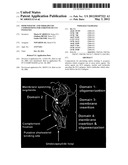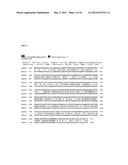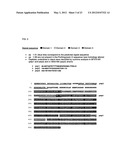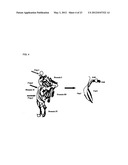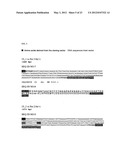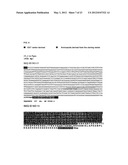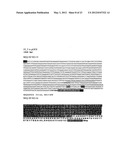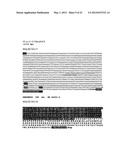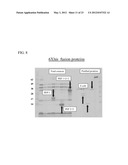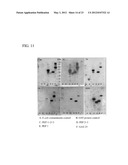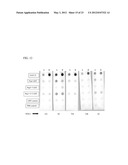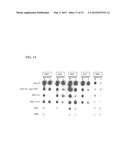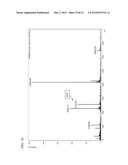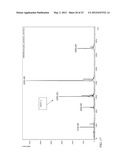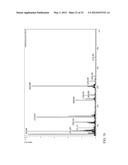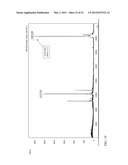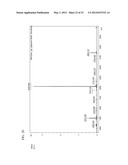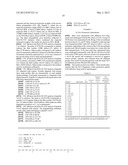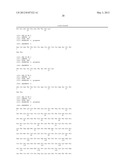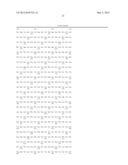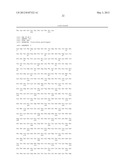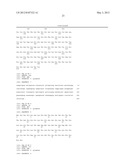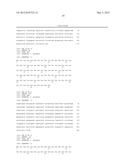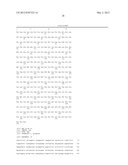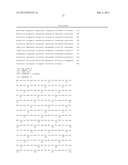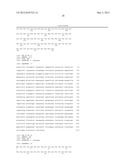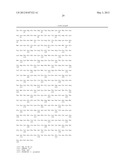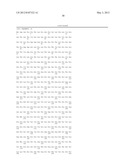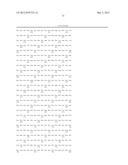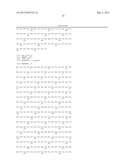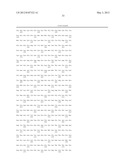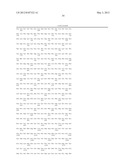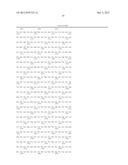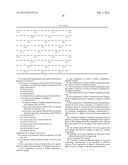Patent application title: IMMUNOGENIC AND THERAPEUTIC COMPOSITIONS FOR STREPTOCOCCUS PYOGENES
Inventors:
Maria Scarselli (Siena, IT)
Giuliano Bensi (Siena, IT)
Giuliano Bensi (Siena, IT)
Guido Grandi (Siena, IT)
Assignees:
NOVARTIS AG
IPC8 Class: AA61K39395FI
USPC Class:
4241391
Class name: Drug, bio-affecting and body treating compositions immunoglobulin, antiserum, antibody, or antibody fragment, except conjugate or complex of the same with nonimmunoglobulin material binds antigen or epitope whose amino acid sequence is disclosed in whole or in part (e.g., binds specifically-identified amino acid sequence, etc.)
Publication date: 2012-05-03
Patent application number: 20120107322
Abstract:
Compositions for preventing and/or treating S. pyogenes infection which
comprise one or more active agents. The active agents are SLO antigens,
nucleic acid molecules encoding the SLO antigens, and/or antibodies which
selectively bind to the SLO antigens.Claims:
1. A composition comprising an active agent selected from the group
consisting of: (a) a Streptococcus pyogenes streptolysin O (SLO) antigen
consisting of an amino acid sequence selected from the group consisting
of: (i) SEQ ID NO:1; (ii) SEQ ID NO:2; (iii) SEQ ID NO:3; (iv) SEQ ID
NO:2 covalently attached to SEQ ID NO:3; (v) an amino acid sequence
consisting of (1) SEQ ID NO:1; (2) a glycine residue covalently attached
to the amino acid sequence SEQ ID NO:1; (3) the amino acid sequence SEQ
ID NO:2 covalently attached to the glycine; and (4) the amino acid
sequence SEQ ID NO:3 covalently attached to the amino acid sequence SEQ
ID NO:2; (vi) SEQ ID NO:8; (vii) SEQ ID NO:10; (vii) amino acids 2-82 of
SEQ ID NO:10; (viii) SEQ ID NO:12; (ix) amino acids 4-156 of SEQ ID
NO:12; (x) SEQ ID NO:14; (xi) SEQ ID NO:16; and (xii) SEQ ID NO:18;
wherein the SLO antigen is non-toxic; (b) a nucleic acid molecule which
encodes the SLO antigen; and (c) an antibody which specifically binds to
the SLO antigen.
2. The composition of claim 1 wherein the active agent is the SLO antigen and wherein the SLO antigen is monomeric.
3. The composition of claim 1 further comprising a Spy0269 antigen.
4. The composition of claim 1 further comprising a Spy0416 antigen.
5. The composition of claim 1 further comprising an antigen which is useful in a pediatric vaccine.
6. The composition of claim 1 further comprising an antigen which is useful in a vaccine for elderly or immunocompromised individuals.
7. The composition of claim 1 further comprising an adjuvant.
8. The composition of claim 1 wherein the active agent is the SLO antigen and the SLO antigen is coupled to a carrier protein.
9. The composition of claim 8 wherein the carrier protein is selected from the group consisting of a bacterial toxin, a bacterial toxoid, a N. meningitidis outer membrane protein, a heat shock protein, a pertussis protein, H. influenzae protein D, a cytokine, a lymphokine, a hormone, a growth factor, C. difficile toxin A, C. difficile toxin B, and an iron-uptake protein.
10. A method of making a vaccine for inducing immunity against S. pyogenes comprising combining the active agent of claim 1 with a pharmaceutically acceptable carrier, wherein the active agent is the SLO antigen or the nucleic acid molecule.
11. The method claim 10 wherein the active agent is the SLO antigen and the SLO antigen is made by a method comprising: (a) culturing a host cell comprising an expression vector which encodes the SLO antigen; and (b) recovering the SLO antigen.
12. A method of inducing immunity against S. pyogenes comprising administering to an individual an effective amount of the composition of claim 1, wherein the active agent is the SLO antigen or the nucleic acid molecule.
Description:
[0001] This application is a division of Ser. No. 12/445,781 filed on Apr.
16, 2009, which is a U.S. national phase application of PCT/US2007/022838
filed on Oct. 30, 2007, which claims priority to and incorporates by
reference provisional application Ser. No. 60/855,114 filed Oct. 30,
2006.
[0002] This application incorporates by reference the contents of a 46.4 KB text file created on Aug. 24, 2010 and named "sequencelisting.txt," which is the sequence listing for this application.
FIELD OF THE INVENTION
[0003] This invention is in the fields of immunology and vaccinology. In particular, it relates to antigens derived from Streptococcus pyogenes and their use in immunization.
BACKGROUND OF THE INVENTION
[0004] Streptolysin O (SLO) is an exotoxin produced by Streptococcus pyogenes and is inactivated by oxygen (hence the "O" in its name). SLO is oxygen-labile and is a prototype of a prominent family of bacterial toxins known as thiol-activated cytolysins (TACYs). Billington et al. 2000 (FEMS Microbiology Letters 18: 197-205).
[0005] Thiol-activated cytolysins are toxins produced by a variety of Gram-positive bacteria. These toxins are reversibly inactivated by oxidation and they are characterized by their ability to bind to cholesterol and to promote lysis of cholesterol-containing membranes by binding to cholesterol-containing membranes wherein they polymerize to form pores. Thiol-activated cytolysins are found in more than 20 Gram-positive bacteria and are intimately involved in the pathogenesis of infections by species such as Arcanobacterium pyogenes (encoding PLO, or pyolysin), Clostridium perfringens (encoding PFO, or perfringolysin), Listeria monocytogenes (encoding LLO, or listeriolysin), and Streptococcus pneumoniae (encoding PLY or PLN, or pneumolysin).
[0006] Sequences of these toxins in different microorganisms are known, e.g, Alveolysin (gene alv) from Bacillus alvei; Ivanolysin (gene ilo) from Listeria ivanovii; Listeriolysin O (gene hlyA) from Listeria monocytogenes; Perfringolysin O (theta-toxin) (gene pfo) from Clostridium perfringens; Pneumolysin (gene ply) from Streptococcus pneumoniae; Seeligeriolysin (gene lso) from Listeria seeligeri; and Streptolysin O (gene, slo) from Streptococcus pyogenes. All these proteins contain a single cysteine residue, located in their C-terminal section, which is essential for the binding to cholesterol. This cysteine is located in a highly conserved region that can be used as a signature pattern.
[0007] It appears that Streptococcus pyogenes uses SLO to translocate an effector protein (e.g., NAD-glycohydrolase) in the host cell which in turn would trigger cytotoxicity. This cytolysin-mediated translocation (CMT) may be the gram-positive equivalent of type III secretion seen in gram-negative pathogens (Cell 2001 104: 143-52).
[0008] Unlike many GAS virulence factors, SLO is expressed by almost all GAS isolates, and is encoded by sequences that appear to be highly conserved among distinct M serotypes of GAS. Streptolysin O is highly immunogenic, and determination of the antibody responses engendered to this protein (ASO titer) is often useful in the serodiagnosis of recent infection. Strong antibody responses to SLO have been shown to correlate with the onset of acute rheumatic fever and acute poststreptococcal glomerulonephritis. SLO evokes a protective innate immune response and is a potent inducer of TNFα and IL-1β (see Bricker et al 2005).
[0009] Because of its immunogenic properties, SLO could be useful in both diagnostic and therapeutic S. pyogenes compositions. Unfortunately, SLO is toxic to a wide variety of cell types, including myocardium. There is, therefore, a need in the art for SLO antigens which are not toxic.
BRIEF DESCRIPTION OF THE FIGURES
[0010] FIG. 1. Three-dimensional crystal structure of the perfringolysin O monomer from Clostridium perfringens.
[0011] FIG. 2. BLAST alignment showing GAS25 homology with perfringolysin O from Clostridium perfringens (SEQ ID NO:6). GAS25 (SEQ ID NO:5) is the query sequence.
[0012] FIG. 3. Prediction of domains in SLO (SEQ ID NO:5) based on the protein sequence homology with Clostridium perfringens perfringolysin O. "pep1" is SEQ ID NO:1; "pep2" is SEQ ID NO:2; "pep3" is SEQ ID NO:3.
[0013] FIG. 4. Construction of fusion polypeptide containing peptides 2 and 3.
[0014] FIG. 5. Cloning and expression of SLO protein fragments as -HIS fusions.
[0015] FIG. 6. Cloning and expression of SLO protein fragments as -GST fusions.
[0016] FIG. 7. Western blot on total bacterial extracts and purified GST fusion proteins using an anti-GAS25 mouse immune serum.
[0017] FIG. 8. Western blot on total bacterial extracts and purified His fusion proteins using an anti-GAS25 mouse immune serum.
[0018] FIG. 9. Western blot on purified GST fusion proteins using an anti-GST mouse immune serum.
[0019] FIG. 10. Western blot on purified His fusion proteins using an anti-6Xhis commercial monoclonal antibody (Amersham).
[0020] FIG. 11. Western Blot with purified GST fusion proteins using different human sera.
[0021] FIG. 12. DOT Blot with purified GST fusion proteins using different sera from GAS healthy adults (A: boiled, B: not boiled).
[0022] FIG. 13. Western Blot with purified GST fusion proteins using different sera from GAS infected children.
[0023] FIG. 14. DOT Blot with boiled (+) and not boiled (-) purified GST fusion proteins using different sera from GAS infected children.
[0024] FIG. 15. PAGE analysis of the 6×HIS fusions of three GAS SLO fragments.
[0025] FIG. 16. MALDI-TOF analysis of peptide 1 in solution.
[0026] FIG. 17. MALDI-TOF analysis of peptide 2+3 in solution.
[0027] FIG. 18. MALDI-TOF analysis of peptide 2+3 digested with trypsin.
[0028] FIG. 19. MALDI-TOF analysis of peptide 1+2+3 in solution.
[0029] FIG. 20. MALDI-TOF analysis of peptide 1+2+3 digested with trypsin.
DETAILED DESCRIPTION OF THE INVENTION
[0030] The invention provides compositions for preventing and/or treating S. pyogenes infection.
[0031] These compositions comprise one or more active agents, which are SLO antigens, nucleic acid molecules encoding the SLO antigens, and/or antibodies which selectively bind to the SLO antigens.
SLO Antigens
[0032] "Streptolysin O (SLO) antigens" according to the invention are immunogenic but not toxic. "Non-toxic" as used herein means that the SLO antigen cannot bind to cholesterol and therefore does not promote lysis of cholesterol-containing membranes. An SLO protein can be rendered non-toxic, for example, by deleting at least the single cysteine residue, located in a highly conserved region in the C-terminal section of SLO that can be used as a signature pattern for thiol-activated cytolysins.
[0033] In some embodiments a Streptococcus pyogenes streptolysin O (SLO) antigen consists essentially of the amino acid sequence SEQ ID NO: 1. In some embodiments an SLO antigen consists essentially of, from N to C terminus, the amino acid sequence SEQ ID NO:2 and the amino acid sequence SEQ ID NO:3 covalently attached to the amino acid sequence SEQ ID NO:2. "Covalently attached" as used herein includes direct covalent linkage as well as linkage via one or more additional amino acids. In other embodiments an SLO antigen consists essentially of, from N to C terminus, the amino acid sequence SEQ ID NO:1; a glycine residue covalently attached to the amino acid sequence SEQ ID NO:1; the amino acid sequence SEQ ID NO:2 covalently attached to the glycine; and the amino acid sequence SEQ ID NO:3 covalently attached to the amino acid sequence SEQ ID NO:2.
[0034] Useful SLO antigens according to the invention also include an amino acid sequence consisting essentially of (1) SEQ ID NO:1; (2) a glycine residue covalently attached to the amino acid sequence SEQ ID NO:1; (3) the amino acid sequence SEQ ID NO:2 covalently attached to the glycine; and (4) the amino acid sequence SEQ ID NO:3 covalently attached to the amino acid sequence SEQ ID NO:2. Still other useful SLO antigens include those consisting essentially of SEQ ID NO:8, SEQ ID NO:10, amino acids 2-82 of SEQ ID NO:10, SEQ ID NO:12, amino acids 4-156 of SEQ ID NO:12, SEQ ID NO:14, SEQ ID NO:16, and SEQ ID NO:18. In some embodiments, the SLO antigen is a monomer.
[0035] As there will be variance among SLO antigens between GAS M types and GAS strain isolates, references to the GAS amino acid or polynucleotide sequences of the invention preferably include amino acid or polynucleotide sequences having sequence identity thereto. Preferred amino acid or polynucleotide sequences have 50% or more sequence identity (e.g., 60%, 65%, 70%, 75%, 80%, 85%, 90%, 91%, 92%, 93%, 94%, 95%, 96%, 97%, 98%, 99%, 99.5% or more). Similarly, references to the SLO amino acid or polynucleotide sequences of the invention preferably include fragments of those sequences which retain or encode for the immunological properties of the SLO antigen. Preferred amino acid fragments include at least n consecutive amino acids, wherein n is 7 or more (e.g., 8, 10, 12, 14, 16, 18, 20, 25, 30, 35, 40, 50 or more).
[0036] Fusion Proteins
[0037] The SLO antigens used in the invention may be present in the composition as individual separate polypeptides ("peptide 1," "peptide 2," "peptide 3," "peptide 1+2+3," "peptide 2+3"), but there also are embodiments in which at least two (i.e., 2, 3, 4, 5, 6, 7, 8, 9, 10, 11, 12, 13, 14, 15, 16, 17, 18, 19 or 20) antigens are expressed as a single polypeptide chain (a "fusion protein" or "hybrid polypeptide"). Hybrid polypeptides offer two principal advantages. First, a polypeptide that may be unstable or poorly expressed on its own can be assisted by adding a suitable hybrid partner that overcomes the problem. Second, commercial manufacture is simplified as only one expression and purification need be employed in order to produce two polypeptides which are both antigenically useful.
[0038] A hybrid polypeptide may comprise two or more polypeptide sequences. Accordingly, the invention includes a composition comprising a first amino acid sequence and a second amino acid sequence, wherein said first and second amino acid sequences are selected from an SLO antigen or a fragment thereof. Preferably, the first and second amino acid sequences in the hybrid polypeptide comprise different epitopes. In other embodiments, the hybrid polypeptide comprises a first amino acid sequence and a second amino acid sequence, said first amino acid sequence selected from an SLO antigen or a fragment thereof and said second amino acid sequence selected from an SLO antigen or a fragment thereof or from another GAS antigen. Preferably, the first and second amino acid sequences in the hybrid polypeptide comprise different epitopes.
[0039] Hybrids consisting of amino acid sequences from two, three, four, five, six, seven, eight, nine, or ten GAS antigens can be constructed. Different hybrid polypeptides may be mixed together in a single formulation. Within such combinations, an SLO antigen may be present in more than one hybrid polypeptide and/or as a non hybrid polypeptide. In some embodiments an antigen is present either as a hybrid or as a non-hybrid, but not as both.
[0040] Hybrid polypeptides can be represented by the formula NH2-A-{-X-L-}n--B--COOH, wherein: X is an amino acid sequence of a GAS antigen or a fragment thereof from the first antigen group or the second antigen group; L is an optional linker amino acid sequence; A is an optional N-terminal amino acid sequence; B is an optional C-terminal amino acid sequence; and n is 2, 3, 4, 5, 6, 7, 8, 9, 10, 11, 12, 13, 14 or 15.
[0041] If a --X-- moiety has a leader peptide sequence in its wild-type form, this may be included or omitted in the hybrid protein. In some embodiments, the leader peptides will be deleted except for that of the --X-- moiety located at the N-terminus of the hybrid protein i.e., the leader peptide of X1 will be retained, but the leader peptides of X2 . . . Xa will be omitted. This is equivalent to deleting all leader peptides and using the leader peptide of X1 as moiety -A-.
[0042] For each n instances of {-X-L-}, linker amino acid sequence -L- may be present or absent. For instance, when n=2 the hybrid may be NH2--X1-L1-X2-L2-COOH, NH2--X1--X2--COOH, NH2--X1-L1-X2--COOH, NH2--X1--X2-L2-COOH, etc. Linker amino acid sequence(s) -L- will typically be short (e.g., 20 or fewer amino acids, i.e., 19, 18, 17, 16, 15, 14, 13, 12, 11, 10, 9, 8, 7, 6, 5, 4, 3, 2, 1). Examples comprise short peptide sequences which facilitate cloning, poly-glycine linkers (i.e., comprising Glyn where n=2, 3, 4, 5, 6, 7, 8, 9, 10 or more), and histidine tags (i.e., H is where n=3, 4, 5, 6, 7, 8, 9, 10 or more). Other suitable linker amino acid sequences will be apparent to those skilled in the art. A useful linker is GSGGGG (SEQ ID NO:21), with the Gly-Ser dipeptide being formed from a BamHI restriction site, thus aiding cloning and manipulation, and the (Gly)4 tetrapeptide being a typical poly-glycine linker.
[0043] A--is an optional N-terminal amino acid sequence. This will typically be short (e.g. 40 or fewer amino acids, i.e., 39, 38, 37, 36, 35, 34, 33, 32, 31, 30, 29, 28, 27, 26, 25, 24, 23, 22, 21, 20, 19, 18, 17, 16, 15, 14, 13, 12, 11, 10, 9, 8, 7, 6, 5, 4, 3, 2, 1). Examples include leader sequences to direct protein trafficking, or short peptide sequences which facilitate cloning or purification (e.g., histidine tags, i.e., Hisn where n=3, 4, 5, 6, 7, 8, 9, 10 or more). Other suitable N-terminal amino acid sequences will be apparent to those skilled in the art. If X1 lacks its own N-terminus methionine, -A- is preferably an oligopeptides (e.g., with 1, 2, 3, 4, 5, 6, 7, or 8 amino acids) which provides an N-terminus methionine.
[0044] B--is an optional C-terminal amino acid sequence. This will typically be short (e.g., 40 or fewer amino acids, i.e., 39, 38, 37, 36, 35, 34, 33, 32, 31, 30, 29, 28, 27, 26, 25, 24, 23, 22, 21, 20, 19, 18, 17, 16, 15, 14, 13, 12, 11, 10, 9, 8, 7, 6, 5, 4, 3, 2, 1). Examples include leader sequences to direct protein trafficking, or short peptide sequences which facilitate cloning or purification (e.g., histidine tags, i.e., Hisn where n=3, 4, 5, 6, 7, 8, 9, 10 or more). Other suitable C-terminal amino acid sequences will be apparent to those skilled in the art.
[0045] Most preferably, n is 2 or 3.
[0046] The fusion constructs of the invention may include a combination of two or more SLO antigens. Preferred combinations include fusions with a GAS40 or GAS57 antigen.
[0047] GAS40
[0048] GAS40 antigens are particularly useful in compositions of the invention because GAS40 proteins are highly conserved both in many M types and in multiple strains of these M types (see WO 2006/042027). GAS40 proteins are described in detail in WO 2005/032582. GAS40 consistently provides protection in the animal model of systemic immunization and challenge and induction of bactericidal antibodies. GAS40 is an extremely highly conserved protein and appears to be exposed on the surface of most M serotypes (the only exception observed thus far is the M3 serotype).
[0049] Amino acid sequences of a number of GAS40 proteins from various M strains are contained in GenBank and have accession numbers GI:13621545 and GI:15674449 (M1); accession number GI: 21909733 (M3), and accession number GI:19745402 (M18). GAS40 proteins also are known as "Spy0269" (M1), "SpyM3--0197" (M3), "SpyM18--0256" (M18) and "prgA."
[0050] A GAS40 protein typically contains a leader peptide sequence (e.g., amino acids 1-26 of SEQ ID NO:19), a first coiled-coil region (e.g., amino acids 58-261 of SEQ ID NO:19), a second coiled coil region (e.g., amino acids 556-733 of SEQ ID NO:19), a leucine zipper region (e.g., amino acids 673-701 of SEQ ID NO:19) and a transmembrane region (e.g., amino acids 855-866 of SEQ ID NO:19).
[0051] Preferred GAS40 proteins for use with the invention comprise an amino acid sequence: (a) having 50% or more identity (e.g. 60%, 65%, 70%, 75%, 80%, 85%, 90%, 91%, 92%, 93%, 94%, 95%, 96%, 97%, 98%, 99%, 99.5% or more) to SEQ ID NO:19; and/or (b) which is a fragment of at least n consecutive amino acids of SEQ ID NO:19, wherein n is 7 or more (e.g. 8, 10, 12, 14, 16, 18, 20, 25, 30, 35, 40, 50, 60, 70, 80, 90, 100, 150, 200 or more). These GAS40 proteins include variants (e.g. allelic variants, homologs, orthologs, paralogs, mutants, etc.) of SEQ ID NO:19. Preferred fragments of a GAS40 protein lack one or more amino acids (e.g., 1, 2, 3, 4, 5, 6, 7, 8, 9, 10, 15, 20, 25 or more) from the C-terminus and/or one or more amino acids (e.g., 1, 2, 3, 4, 5, 6, 7, 8, 9, 10, 15, 20, 25 or more) from the N-terminus of the GAS40 protein. In one embodiment, the leader sequence is removed. In another embodiment, the transmembrane region is removed. Other fragments may omit one or more other domains of the GAS40 protein.
[0052] The coiled-coil regions of GAS40 are likely involved in the formation of oligomers such as dimers or trimers. Such oligomers could be homomers (containing two or more GAS40 proteins oligomerized together) or heteromers (containing one or more additional GAS proteins oligomerized with GAS40). Alternatively, two coiled-coil regions may interact together within the GAS40 protein to form oligomeric reactions between the first and second coiled-coil regions. Thus, in some embodiments the GAS40 antigen is in the form of an oligomer. Some oligomers comprise two more GAS40 antigens. Other oligomers comprise a GAS40 antigen oligomerized to a second GAS antigen.
[0053] GAS57
[0054] GAS57 corresponds to M1 GenBank accession numbers GI:13621655 and GI:15674549, to M3 GenBank accession number GI: 21909834, to M18 GenBank accession number GI: 19745560 and is also referred to as `Spy0416` (M1), `SpyM3--0298` (M3), `SpyM18--0464` (M18) and `prtS.` GAS57 has also been identified as a putative cell envelope proteinase. The amino acid sequence of GAS57 of an M1 strain is set forth in the sequence listing as SEQ ID NO:20.
[0055] Preferred GAS57 proteins for use with the invention comprise an amino acid sequence: (a) having 50% or more identity (e.g. 60%, 65%, 70%, 75%, 80%, 85%, 90%, 91%, 92%, 93%, 94%, 95%, 96%, 97%, 98%, 99%, 99.5% or more) to SEQ ID NO:20; and/or (b) which is a fragment of at least n consecutive amino acids of SEQ ID NO:20, wherein n is 7 or more (e.g. 8, 10, 12, 14, 16, 18, 20, 25, 30, 35, 40, 50, 60, 70, 80, 90, 100, 150, 200 or more). These GAS57 proteins include variants (e.g. allelic variants, homologs, orthologs, paralogs, mutants, etc.) of SEQ ID NO:20. Preferred fragments of (b) comprise an epitope from SEQ ID NO:20. Other preferred fragments lack one or more amino acids (e.g. 1, 2, 3, 4, 5, 6, 7, 8, 9, 10, 15, 20, 25 or more) from the C-terminus and/or one or more amino acids (e.g. 1, 2, 3, 4, 5, 6, 7, 8, 9, 10, 15, 20, 25 or more) from the N-terminus of SEQ ID NO:20. For example, in one embodiment, amino acids 1-33 are removed. In another example, amino acids 1614-1647 or SEQ ID NO:20 are removed. Other fragments omit one or more domains of the protein (e.g. omission of a signal peptide, of a cytoplasmic domain, of a transmembrane domain, or of an extracellular domain).
Nucleic Acid Molecules
[0056] The invention includes nucleic acid molecules which encode SLO antigens. The invention also includes nucleic acid molecules comprising nucleotide sequences having at least 50% sequence identity to such molecules. Depending on the particular sequence, the degree of sequence identity is preferably greater than 50% (e.g., 60%, 70%, 75%, 80%, 85%, 90%, 91%, 92%, 93%, 94%, 95%, 96%, 97%, 98%, 99% or more). Identity between nucleotide sequences is preferably determined by the Smith-Waterman homology search algorithm as implemented in the MPSRCH program (Oxford Molecular), using an affine gap search with parameters gap open penalty=12 and gap extension penalty=1.
[0057] The invention also provides nucleic acid molecules which can hybridize to these molecules. Hybridization reactions can be performed under conditions of different "stringency." Conditions which increase stringency of a hybridization reaction are widely known and published in the art. See, e.g., page 7.52 of Sambrook et al., Molecular Cloning: A Laboratory Manual, 1989. Examples of relevant conditions include (in order of increasing stringency): incubation temperatures of 25° C., 37° C., 50° C., 55° C., and 68° C.; buffer concentrations of 10×SSC, 6×SSC, 1×SSC, and 0.1×SSC (where SSC is 0.15 M NaCl and 15 mM citrate buffer) and their equivalents using other buffer systems; formamide concentrations of 0%, 25%, 50%, and 75%; incubation times from 5 minutes to 24 hours; 1, 2, or more washing steps; wash incubation times of 1, 2, or 15 minutes; and wash solutions of 6×SSC, 1×SSC, 0.1×SSC, or de-ionized water. Hybridization techniques and their optimization are well known in the art. See, e.g., Sambrook, 1989; Ausubel et al., eds., Short Protocols in Molecular Biology, 4th ed., 1999; U.S. Pat. No. 5,707,829; Ausubel et al., eds., Current Protocols in Molecular Biology, Supplement 30, 1987.
[0058] In some embodiments, nucleic acid molecules of the invention hybridize to a target under low stringency conditions; in other embodiments, nucleic acid molecules of the invention hybridize under intermediate stringency conditions; in preferred embodiments, nucleic acid molecules of the invention hybridize under high stringency conditions. An example of a low stringency hybridization condition is 50° C. and 10×SSC. An example of an intermediate stringency hybridization condition is 55° C. and 1×SSC. An example of a high stringency hybridization condition is 68° C. and 0.1×SSC.
[0059] Nucleic acid molecules comprising fragments of these sequences are also included in the invention. These comprise at least n consecutive nucleotides of these sequences and, depending on the particular sequence, n is 10 or more (e.g., 12, 14, 15, 18, 20, 25, 30, 35, 40, 50, 60, 70, 80, 90, 100, 150, 200, or more).
[0060] Nucleic acids (and polypeptides) of the invention may include sequences which:
[0061] (a) are identical (i.e., 100% identical) to the sequences disclosed in the sequence listing;
[0062] (b) share sequence identity with the sequences disclosed in the sequence listing;
[0063] (c) have 1, 2, 3, 4, 5, 6, 7, 8, 9, or 10 single nucleotide or amino acid alterations (deletions, insertions, substitutions), which may be at separate locations or may be contiguous, as compared to the sequences of (a) or (b); and,
[0064] d) when aligned with a particular sequence from the sequence listing using a pairwise alignment algorithm, a moving window of x monomers (amino acids or nucleotides) moving from start (N-terminus or 5') to end (C-terminus or 3'), such that for an alignment that extends to p monomers (where p>x) there are p-x+1 such windows, each window has at least xy identical aligned monomers, where: x is selected from 20, 25, 30, 35, 40, 45, 50, 60, 70, 80, 90, 100, 150, 200; y is selected from 0.50, 0.60, 0.70, 0.75, 0.80, 0.85, 0.90, 0.91, 0.92, 0.93, 0.94, 0.95, 0.96, 0.97, 0.98, 0.99; and if xy is not an integer then it is rounded up to the nearest integer. The preferred pairwise alignment algorithm is the Needleman-Wunsch global alignment algorithm [Needleman & Wunsch (1970) J. Mol. Biol. 48, 443-453], using default parameters (e.g., with Gap opening penalty=10.0, and with Gap extension penalty=0.5, using the EBLOSUM62 scoring matrix). This algorithm is conveniently implemented in the needle tool in the EMBOSS package [Rice et al. (2000) Trends Genet. 16:276-277].
[0065] The nucleic acids and polypeptides of the invention may additionally have further sequences to the N-terminus/5' and/or C-terminus/3' of these sequences (a) to (d).
Antibodies
[0066] Antibodies can be generated to bind specifically to an SLO antigen of the invention. The term "antibody" includes intact immunoglobulin molecules, as well as fragments thereof which are capable of binding an antigen. These include hybrid (chimeric) antibody molecules (e.g., Winter et al., Nature 349, 293-99, 1991; U.S. Pat. No. 4,816,567); F(ab')2 and F(ab) fragments and Fv molecules; non-covalent heterodimers (e.g., Inbar et al., Proc. Natl. Acad. Sci. U.S.A. 69, 2659-62, 1972; Ehrlich et al., Biochem 19, 4091-96, 1980); single-chain Fv molecules (sFv) (e.g., Huston et al., Proc. Natl. Acad. Sci. U.S.A. 85, 5897-83, 1988); dimeric and trimeric antibody fragment constructs; minibodies (e.g., Pack et al., Biochem 31, 1579-84, 1992; Cumber et al., J. Immunology 149B, 120-26, 1992); humanized antibody molecules (e.g., Riechmann et al., Nature 332, 323-27, 1988; Verhoeyan et al., Science 239, 1534-36, 1988; and U.K. Patent Publication No. GB 2,276,169, published 21 Sep. 1994); and any functional fragments obtained from such molecules, as well as antibodies obtained through non-conventional processes such as phage display. Preferably, the antibodies are monoclonal antibodies. Methods of obtaining monoclonal antibodies are well known in the art.
[0067] Typically, at least 6, 7, 8, 10, or 12 contiguous amino acids are required to form an epitope. However, epitopes which involve non-contiguous amino acids may require more, e.g., at least 15, 25, or 50 amino acids. Various immunoassays (e.g., Western blots, ELISAs, radioimmunoassays, immunohistochemical assays, immunoprecipitations, or other immunochemical assays known in the art) can be used to identify antibodies having the desired specificity. Numerous protocols for competitive binding or immunoradiometric assays are well known in the art. Such immunoassays typically involve the measurement of complex formation between an immunogen and an antibody which specifically binds to the immunogen. A preparation of antibodies which specifically bind to a particular antigen typically provides a detection signal at least 5-, 10-, or 20-fold higher than a detection signal provided with other proteins when used in an immunochemical assay. Preferably, the antibodies do not detect other proteins in immunochemical assays and can immunoprecipitate the particular antigen from solution.
[0068] Generation of Antibodies
[0069] SLO antigens or non-SLO polypeptide antigens (described below) can be used to immunize a mammal, such as a mouse, rat, rabbit, guinea pig, monkey, or human, to produce polyclonal antibodies. If desired, an antigen can be conjugated to a carrier protein, such as bovine serum albumin, thyroglobulin, and keyhole limpet hemocyanin. Depending on the host species, various adjuvants can be used to increase the immunological response. Such adjuvants include, but are not limited to, Freund's adjuvant, mineral gels (e.g., aluminum hydroxide), and surface active substances (e.g. lysolecithin, pluronic polyols, polyanions, peptides, oil emulsions, keyhole limpet hemocyanin, and dinitrophenol). Among adjuvants used in humans, BCG (bacilli Calmette-Guerin) and Corynebacterium parvum are especially useful.
[0070] Monoclonal antibodies which specifically bind to an antigen can be prepared using any technique which provides for the production of antibody molecules by continuous cell lines in culture. These techniques include, but are not limited to, the hybridoma technique, the human B cell hybridoma technique, and the EBV hybridoma technique (Kohler et al., Nature 256, 495 497, 1985; Kozbor et al., J. Immunol. Methods 81, 31 42, 1985; Cote et al., Proc. Natl. Acad. Sci. 80, 2026 2030, 1983; Cole et al., Mol. Cell. Biol. 62, 109 120, 1984).
[0071] In addition, techniques developed for the production of "chimeric antibodies," the splicing of mouse antibody genes to human antibody genes to obtain a molecule with appropriate antigen specificity and biological activity, can be used (Morrison et al., Proc. Natl. Acad. Sci. 81, 68516855, 1984; Neuberger et al., Nature 312, 604 608, 1984; Takeda et al., Nature 314, 452 454, 1985). Monoclonal and other antibodies also can be "humanized" to prevent a patient from mounting an immune response against the antibody when it is used therapeutically. Such antibodies may be sufficiently similar in sequence to human antibodies to be used directly in therapy or may require alteration of a few key residues. Sequence differences between rodent antibodies and human sequences can be minimized by replacing residues which differ from those in the human sequences by site directed mutagenesis of individual residues or by grating of entire complementarity determining regions.
[0072] Alternatively, humanized antibodies can be produced using recombinant methods, as described below. Antibodies which specifically bind to a particular antigen can contain antigen binding sites which are either partially or fully humanized, as disclosed in U.S. Pat. No. 5,565,332.
[0073] Alternatively, techniques described for the production of single chain antibodies can be adapted using methods known in the art to produce single chain antibodies which specifically bind to a particular antigen. Antibodies with related specificity, but of distinct idiotypic composition, can be generated by chain shuffling from random combinatorial immunoglobin libraries (Burton, Proc. Natl. Acad. Sci. 88, 11120 23, 1991).
[0074] Single-chain antibodies also can be constructed using a DNA amplification method, such as PCR, using hybridoma cDNA as a template (Thirion et al., 1996, Eur. J. Cancer Prey. 5, 507-11). Single-chain antibodies can be mono- or bispecific, and can be bivalent or tetravalent. Construction of tetravalent, bispecific single-chain antibodies is taught, for example, in Coloma & Morrison, 1997, Nat. Biotechnol. 15, 159-63. Construction of bivalent, bispecific single-chain antibodies is taught in Mallender & Voss, 1994, J. Biol. Chem. 269, 199-206.
[0075] A nucleotide sequence encoding a single-chain antibody can be constructed using manual or automated nucleotide synthesis, cloned into an expression construct using standard recombinant DNA methods, and introduced into a cell to express the coding sequence, as described below. Alternatively, single-chain antibodies can be produced directly using, for example, filamentous phage technology (Verhaar et al., 1995, Int. J. Cancer 61, 497-501; Nicholls et al., 1993, J. Immunol. Meth. 165, 81-91).
[0076] Antibodies which specifically bind to a particular antigen also can be produced by inducing in vivo production in the lymphocyte population or by screening immunoglobulin libraries or panels of highly specific binding reagents as disclosed in the literature (Orlandi et al., Proc. Natl. Acad. Sci. 86, 3833 3837, 1989; Winter et al., Nature 349, 293 299, 1991).
[0077] Chimeric antibodies can be constructed as disclosed in WO 93/03151. Binding proteins which are derived from immunoglobulins and which are multivalent and multispecific, such as the "diabodies" described in WO 94/13804, also can be prepared.
[0078] Antibodies can be purified by methods well known in the art. For example, antibodies can be affinity purified by passage over a column to which the relevant antigen is bound. The bound antibodies can then be eluted from the column using a buffer with a high salt concentration.
Production of Polypeptide Antigens
[0079] Recombinant Production of Polypeptides
[0080] Any nucleotide sequence which encodes a particular antigen can be used to produce that antigen recombinantly. If desired, an antibody can be produced recombinantly once its amino acid sequence is known.
[0081] Examples of sequences which can be used to produce SLO antigens of the invention are shown in FIGS. 5 and 6. Nucleic acid molecules encoding SLO can be isolated from the appropriate S. pyogenes bacterium using standard nucleic acid purification techniques or can be synthesized using an amplification technique, such as the polymerase chain reaction (PCR), or by using an automatic synthesizer. Methods for isolating nucleic acids are routine and are known in the art. Any such technique for obtaining nucleic acid molecules can be used to obtain a nucleic acid molecule which encodes a particular antigen. Sequences encoding a particular antigen or antibody can be synthesized, in whole or in part, using chemical methods well known in the art (see Caruthers et al., Nucl. Acids Res. Symp. Ser. 215 223, 1980; Horn et al. Nucl. Acids Res. Symp. Ser. 225 232, 1980).
[0082] cDNA molecules can be made with standard molecular biology techniques, using mRNA as a template. cDNA molecules can thereafter be replicated using molecular biology techniques well known in the art. An amplification technique, such as PCR, can be used to obtain additional copies of polynucleotides of the invention, using either genomic DNA or cDNA as a template.
[0083] If desired, nucleotide sequences can be engineered using methods generally known in the art to alter antigen-encoding sequences for a variety of reasons, including but not limited to, alterations which modify the cloning, processing, and/or expression of the polypeptide or mRNA product. DNA shuffling by random fragmentation and PCR reassembly of gene fragments and synthetic oligonucleotides can be used to engineer the nucleotide sequences. For example, site directed mutagenesis can be used to insert new restriction sites, alter glycosylation patterns, change codon preference, produce splice variants, introduce mutations, and so forth.
[0084] Sequence modifications, such as the addition of a purification tag sequence or codon optimization, can be used to facilitate expression. For example, the N-terminal leader sequence may be replaced with a sequence encoding for a tag protein such as polyhistidine ("HIS") or glutathione S-transferase ("GST"). Such tag proteins may be used to facilitate purification, detection, and stability of the expressed protein. Codons preferred by a particular prokaryotic or eukaryotic host can be selected to increase the rate of protein expression or to produce an RNA transcript having desirable properties, such as a half life which is longer than that of a transcript generated from the naturally occurring sequence. These methods are well known in the art and are further described in WO05/032582.
[0085] Expression Vectors
[0086] A nucleic acid molecule which encodes an antigen or antibody can be inserted into an expression vector which contains the necessary elements for the transcription and translation of the inserted coding sequence. Methods which are well known to those skilled in the art can be used to construct expression vectors containing coding sequences and appropriate transcriptional and translational control elements. These methods include in vitro recombinant DNA techniques, synthetic techniques, and in vivo genetic recombination.
[0087] Host Cells
[0088] The heterologous host can be prokaryotic or eukaryotic. E. coli is a preferred host cell, but other suitable hosts include Lactococcus lactis, Lactococcus cremoris, Bacillus subtilis, Vibrio cholerae, Salmonella typhi, Salmonella typhimurium, Neisseria lactamica, Neisseria cinerea, Mycobacteria (e.g., M. tuberculosis), yeasts, etc.
[0089] A host cell strain can be chosen for its ability to modulate the expression of the inserted sequences or to process the expressed polypeptide in the desired fashion. Such modifications of the polypeptide include, but are not limited to, acetylation, carboxylation, glycosylation, phosphorylation, lipidation, and acylation. Post translational processing which cleaves a "prepro" form of the polypeptide also can be used to facilitate correct insertion, folding and/or function. Different host cells which have specific cellular machinery and characteristic mechanisms for post translational activities are available from the American Type Culture Collection (ATCC; 10801 University Boulevard, Manassas, Va. 20110-2209) and can be chosen to ensure the correct modification and processing of a foreign protein. See WO 01/98340.
[0090] Expression constructs can be introduced into host cells using well-established techniques which include, but are not limited to, transferrin-polycation-mediated DNA transfer, transfection with naked or encapsulated nucleic acids, liposome-mediated cellular fusion, intracellular transportation of DNA-coated latex beads, protoplast fusion, viral infection, electroporation, "gene gun" methods, and DEAE- or calcium phosphate-mediated transfection.
[0091] Host cells transformed with expression vectors can be cultured under conditions suitable for the expression and recovery of the protein from cell culture. The protein produced by a transformed cell can be secreted or contained intracellularly depending on the nucleotide sequence and/or the expression vector used. Those of skill in the art understand that expression vectors can be designed to contain signal sequences which direct secretion of soluble antigens through a prokaryotic or eukaryotic cell membrane.
[0092] Purification
[0093] Antigens used in the invention can be isolated from the appropriate Streptococcus pyogenes bacterium or from an engineered host cell. A purified polypeptide antigen is separated from other components in the cell, such as proteins, carbohydrates, or lipids, using methods well-known in the art. Such methods include, but are not limited to, size exclusion chromatography, ammonium sulfate fractionation, ion exchange chromatography, affinity chromatography, and preparative gel electrophoresis. A preparation of purified polypeptide antigens is at least 80% pure; preferably, the preparations are 90%, 95%, or 99% pure. Purity of the preparations can be assessed by any means known in the art, such as SDS-polyacrylamide gel electrophoresis. Where appropriate, polypeptide antigens can be solubilized, for example, with urea.
[0094] Chemical Synthesis
[0095] SLO antigens, as well as other antigens used in compositions of the invention, can be synthesized, for example, using solid phase techniques. See, e.g., Merrifield, J. Am. Chem. Soc. 85, 2149 54, 1963; Roberge et al., Science 269, 202 04, 1995. Protein synthesis can be performed using manual techniques or by automation. Automated synthesis can be achieved, for example, using Applied Biosystems 431A Peptide Synthesizer (Perkin Elmer). Optionally, fragments of an SLO antigen can be separately synthesized and combined using chemical methods to produce a full-length molecule.
[0096] Nucleic acid molecules which encode antibodies or polypeptide antigens can be synthesized by conventional methodology, such as the phosphate triester method (Hunkapiller, M. et al. (1984), Nature 310: 105-111) or by the chemical synthesis of nucleic acids (Grantham, R. et al. (1981), Nucleic Acids Res. 9: r43-r74).
Immunogenic, Diagnostic, and Therapeutic Compositions
[0097] The invention also provides compositions for use as medicaments (e.g., as immunogenic compositions or vaccines) or as diagnostic reagents for detecting a GAS infection in a host subject. It also provides the use of the compositions in the manufacture of (i) a medicament for treating or preventing infection due to GAS bacteria; (ii) a diagnostic reagent for detecting the presence of GAS bacteria or of antibodies raised against GAS bacteria; and/or (iii) a reagent which can raise antibodies against GAS bacteria.
[0098] For example, SLO antigens or nucleic acids encoding the antigens can be used in the manufacture of a diagnostic reagent for detecting the presence of a GAS infection or for detecting antibodies raised against GAS bacteria, or in the manufacture of a reagent which can raise antibodies against GAS bacteria. Nucleic acids encoding SLO antigens can be detected by contacting a nucleic acid probe with a biological sample under hybridizing conditions to form duplexes and detecting the duplexes as is known in the art. An SLO antigen can be detected using antibodies which specifically bind to the SLO antigen. Similarly, antibodies to SLO antigens can be used to detect SLO antigens by contacting a biological sample under conditions suitable for the formation of antibody-antigen complexes and detecting any complexes formed. The invention also provides kits comprising reagents suitable for use these methods.
Therapeutic Compositions
[0099] Compositions of the invention are useful for preventing and/or treating S. pyogenes infection. Compositions containing SLO antigens are preferably immunogenic compositions, and are more preferably vaccine compositions. The pH of such compositions preferably is between 6 and 8, preferably about 7. The pH can be maintained by the use of a buffer. The composition can be sterile and/or pyrogen free. The composition can be isotonic with respect to humans.
[0100] Vaccines according to the invention may be used either prophylactically or therapeutically, but will typically be prophylactic. Accordingly, the invention includes a method for the therapeutic or prophylactic treatment of a Streptococcus pyogenes infection. The animal is preferably a mammal, most preferably a human. The methods involve administering to the animal a therapeutic or prophylactic amount of the immunogenic compositions of the invention.
[0101] Some compositions of the invention comprise a polypeptide SLO antigen as described herein. Other compositions of the invention comprise a nucleic acid molecule which encodes the SLO antigen(s) and, optionally, other antigens which can be included in the composition (see below). See, e.g., Robinson & Torres (1997) Seminars in Immunology 9:271-283; Donnelly et al. (1997) Ann. Rev Immunol 15:617-648; Scott-Taylor & Dalgleish (2000) Expert Opin Investig Drugs 9:471-480; Apostolopoulos & Plebanski (2000) Curr Opin Mol Ther 2:441-447; Ilan (1999) Curr Opin Mol Ther 1:116-120; Dubensky et al. (2000) Mol Med 6:723-732; Robinson & Pertmer (2000) Adv Virus Res 55:1-74; Donnelly et al. (2000) Am J Respir Crit. Care Med 162(4 Pt 2):S190-193; Davis (1999) Mt. Sinai J. Med. 66:84-90. Typically the nucleic acid molecule is a DNA molecule, e.g., in the form of a plasmid.
[0102] Compositions for treating S. pyogenes infections comprise at least one antibody which specifically binds to an SLO antigen and, optionally, an antibody which specifically binds to a non-SLO antigen. Some compositions of the invention are immunogenic and comprise one or more polypeptide antigens, while other immunogenic compositions comprise nucleic acid molecules which encode one or more antigens. See, e.g., Robinson & Torres (1997) Seminars in Immunology 9:271-283; Donnelly et al. (1997) Ann. Rev Immunol 15:617-648; Scott-Taylor & Dalgleish (2000) Expert Opin Investig Drugs 9:471-480; Apostolopoulos & Plebanski (2000) Curr Opin Mol Ther 2:441-447; Ilan (1999) Curr Opin Mol Ther 1:116-120; Dubensky et al. (2000) Mol Med 6:723-732; Robinson & Pertmer (2000) Adv Virus Res 55:1-74; Donnelly et al. (2000) Am J Respir Crit. Care Med 162 (4 Pt 2):S190-193 Davis (1999) Mt. Sinai J. Med. 66:84-90. Typically the nucleic acid molecule is a DNA molecule, e.g., in the form of a plasmid.
[0103] In some embodiments, compositions of the invention can include one or more additional active agents. Such agents include, but are not limited to, (a) another SLO antigen of the invention, (b) a polypeptide antigen which is useful in a pediatric vaccine, (c) a polypeptide antigen which is useful in a vaccine for elderly or immunocompromised individuals, (d) a nucleic acid molecule encoding (a)-(c), and an antibody which specifically binds to (a)-(c).
[0104] Additional Antigens
[0105] Compositions of the invention may be administered in conjunction with one or more antigens for use in therapeutic, prophylactic, or diagnostic methods of the present invention. Preferred antigens include those listed below. Additionally, the compositions of the present invention may be used to treat or prevent infections caused by any of the below-listed pathogens. In addition to combination with the antigens described below, the compositions of the invention may also be combined with an adjuvant as described herein.
[0106] Antigens for use with the invention include, but are not limited to, one or more of the following antigens set forth below, or antigens derived from one or more of the pathogens set forth below:
A. BACTERIAL ANTIGENS
[0107] Bacterial antigens suitable for use in the invention include proteins, polysaccharides, lipopolysaccharides, and outer membrane vesicles which may be isolated, purified or derived from a bacteria. In addition, bacterial antigens may include bacterial lysates and inactivated bacteria formulations. Bacteria antigens may be produced by recombinant expression. Bacterial antigens preferably include epitopes which are exposed on the surface of the bacteria during at least one stage of its life cycle. Bacterial antigens are preferably conserved across multiple serotypes. Bacterial antigens include antigens derived from one or more of the bacteria set forth below as well as the specific antigens examples identified below.
[0108] Neisseria meningitides: Meningitides antigens may include proteins (such as those identified in References 1-7), saccharides (including a polysaccharide, oligosaccharide or lipopolysaccharide), or outer-membrane vesicles (References 8, 9, 10, 11) purified or derived from N. meningitides serogroup such as A, C, W135, Y, and/or B. Meningitides protein antigens may be selected from adhesions, autotransporters, toxins, Fe acquisition proteins, and membrane associated proteins (preferably integral outer membrane protein).
[0109] Streptococcus pneumoniae: Streptococcus pneumoniae antigens may include a saccharide (including a polysaccharide or an oligosaccharide) and/or protein from Streptococcus pneumoniae. Saccharide antigens may be selected from serotypes 1, 2, 3, 4, 5, 6B, 7F, 8, 9N, 9V, 10A, 11A, 12F, 14, 15B, 17F, 18C, 19A, 19F, 20, 22F, 23F, and 33F. Protein antigens may be selected from a protein identified in WO 98/18931, WO 98/18930, U.S. Pat. No. 6,699,703, U.S. Pat. No. 6,800,744, WO 97/43303, and WO 97/37026. Streptococcus pneumoniae proteins may be selected from the Poly Histidine Triad family (PhtX), the Choline Binding Protein family (CbpX), CbpX truncates, LytX family, LytX truncates, CbpX truncate-LytX truncate chimeric proteins, pneumolysin (Ply), PspA, PsaA, Sp128, Sp101, Sp130, Sp125 or Sp133.
[0110] Streptococcus pyogenes (Group A Streptococcus): Group A Streptococcus antigens may include a protein identified in WO 02/34771 or WO 2005/032582 (including GAS 40), fusions of fragments of GAS M proteins (including those described in WO 02/094851, and Dale, Vaccine (1999) 17:193-200, and Dale, Vaccine 14(10): 944-948), fibronectin binding protein (Sfb1), Streptococcal heme-associated protein (Shp), and Streptolysin S (SagA).
[0111] Moraxella catarrhalis: Moraxella antigens include antigens identified in WO 02/18595 and WO 99/58562, outer membrane protein antigens (HMW-OMP), C-antigen, and/or LPS.
[0112] Bordetella pertussis: Pertussis antigens include petussis holotoxin (PT) and filamentous haemagglutinin (FHA) from B. pertussis, optionally also combination with pertactin and/or agglutinogens 2 and 3 antigen.
[0113] Staphylococcus aureus: Staphylococcus aureus antigens include S. aureus type 5 and 8 capsular polysaccharides optionally conjugated to nontoxic recombinant Pseudomonas aeruginosa exotoxin A, such as StaphVAX®, or antigens derived from surface proteins, invasins (leukocidin, kinases, hyaluronidase), surface factors that inhibit phagocytic engulfment (capsule, Protein A), carotenoids, catalase production, Protein A, coagulase, clotting factor, and/or membrane-damaging toxins (optionally detoxified) that lyse eukaryotic cell membranes (hemolysins, leukotoxin, leukocidin).
[0114] Staphylococcus epidermis: S. epidermidis antigens include slime-associated antigen (SAA).
[0115] Clostridium tetani (Tetanus): Tetanus antigens include tetanus toxoid (TT), preferably used as a carrier protein in conjunction/conjugated with the compositions of the present invention.
[0116] Cornynebacterium diphtheriae (Diphtheria): Diphtheria antigens include diphtheria toxin, preferably detoxified, such as CRM197. Additionally antigens capable of modulating, inhibiting or associated with ADP ribosylation are contemplated for combination/co-administration/conjugation with the compositions of the present invention. The diphtheria toxoids may be used as carrier proteins.
[0117] Haemophilus influenzae B (Hib): Hib antigens include a Hib saccharide antigen.
[0118] Pseudomonas aeruginosa: Pseudomonas antigens include endotoxin A, Wzz protein, P. aeruginosa LPS, more particularly LPS isolated from PAO1 (O5 serotype), and/or Outer Membrane Proteins, including Outer Membrane Proteins F (OprF) (Infect Immun. 2001 May; 69(5): 3510-3515).
[0119] Legionella pneumophila. Bacterial antigens may be derived from Legionella pneumophila.
[0120] Streptococcus agalactiae (Group B Streptococcus): Group B Streptococcus antigens include a protein or saccharide antigen identified in WO 02/34771, WO 03/093306, WO 04/041157, or WO 2005/002619 (including proteins GBS 80, GBS 104, GBS 276 and GBS 322, and including saccharide antigens derived from serotypes Ia, Ib, Ia/c, II, III, IV, V, VI, VII and VIII).
[0121] Neiserria gonorrhoeae: Gonorrhoeae antigens include Por (or porin) protein, such as PorB (see Zhu et al., Vaccine (2004) 22:660-669), a transferring binding protein, such as TbpA and TbpB (See Price et al., Infection and Immunity (2004) 71(1):277-283), a opacity protein (such as Opa), a reduction-modifiable protein (Rmp), and outer membrane vesicle (OMV) preparations (see Plante et al., J Infectious Disease (2000) 182:848-855), also see e.g. WO99/24578, WO99/36544, WO99/57280, WO02/079243).
[0122] Chlamydia trachomatis: Chlamydia trachomatis antigens include antigens derived from serotypes A, B, Ba and C (agents of trachoma, a cause of blindness), serotypes L1, L2 & L3 (associated with Lymphogranuloma venereum), and serotypes, D-K. Chlamydia trachomas antigens may also include an antigen identified in WO 00/37494, WO 03/049762, WO 03/068811, or WO 05/002619, including PepA (CT045), LcrE (CT089), ArtJ (CT381), DnaK (CT396), CT398, OmpH-like (CT242), L7/L12 (CT316), OmcA (CT444), AtosS (CT467), CT547, Eno (CT587), HrtA (CT823), and MurG (CT761).
[0123] Treponema pallidum (Syphilis): Syphilis antigens include TmpA antigen.
[0124] Haemophilus ducreyi (causing chancroid): Ducreyi antigens include outer membrane protein (DsrA).
[0125] Enterococcus faecalis or Enterococcus faecium: Antigens include a trisaccharide repeat or other Enterococcus derived antigens provided in U.S. Pat. No. 6,756,361.
[0126] Helicobacter pylori: H. pylori antigens include Cag, Vac, Nap, HopX, HopY and/or urease antigen.
[0127] Staphylococcus saprophyticus: Antigens include the 160 kDa hemagglutinin of S. saprophyticus antigen.
[0128] Yersinia enterocolitica antigens include LPS (Infect Immun. 2002 August; 70(8): 4414).
[0129] E. coli: E. coli antigens may be derived from enterotoxigenic E. coli (ETEC), enteroaggregative E. coli (EAggEC), diffusely adhering E. coli (DAEC), enteropathogenic E. coli (EPEC), and/or enterohemorrhagic E. coli (EHEC).
[0130] Bacillus anthracis (anthrax): B. anthracis antigens are optionally detoxified and may be selected from A-components (lethal factor (LF) and edema factor (EF)), both of which can share a common B-component known as protective antigen (PA).
[0131] Yersinia pestis (plague): Plague antigens include F1 capsular antigen (Infect Immun. 2003 January; 71(1)): 374-383, LPS (Infect Immun. 1999 October; 67(10): 5395), Yersinia pestis V antigen (Infect Immun. 1997 November; 65(11): 4476-4482).
[0132] Mycobacterium tuberculosis: Tuberculosis antigens include lipoproteins, LPS, BCG antigens, a fusion protein of antigen 85B (Ag85B) and/or ESAT-6 optionally formulated in cationic lipid vesicles (Infect Immun. 2004 October; 72(10): 6148), Mycobacterium tuberculosis (Mtb) isocitrate dehydrogenase associated antigens (Proc Natl Acad Sci USA. 2004 Aug. 24; 101(34): 12652), and/or MPT51 antigens (Infect Immun. 2004 July; 72(7): 3829).
[0133] Rickettsia: Antigens include outer membrane proteins, including the outer membrane protein A and/or B (OmpB) (Biochim Biophys Acta. 2004 Nov. 1; 1702(2):145), LPS, and surface protein antigen (SPA) (J. Autoimmun. 1989 June; 2 Suppl:81).
[0134] Listeria monocytogenes. Bacterial antigens may be derived from Listeria monocytogenes.
[0135] Chlamydia pneumoniae: Antigens include those identified in WO 02/02606.
[0136] Vibrio cholerae: Antigens include proteinase antigens, LPS, particularly lipopolysaccharides of Vibrio cholerae II, O1 Inaba O-specific polysaccharides, V. cholera 0139, antigens of IEM108 vaccine (Infect Immun. 2003 October; 71(10):5498-504), and/or Zonula occludens toxin (Zot).
[0137] Salmonella typhi (typhoid fever): Antigens include capsular polysaccharides preferably conjugates (Vi, i.e. vax-TyVi).
[0138] Borrelia burgdorferi (Lyme disease): Antigens include lipoproteins (such as OspA, OspB, Osp C and Osp D), other surface proteins such as OspE-related proteins (Ems), decorin-binding proteins (such as DbpA), and antigenically variable VI proteins, such as antigens associated with P39 and P13 (an integral membrane protein, Infect Immun. 2001 May; 69(5): 3323-3334), VlsE Antigenic Variation Protein (J Clin Microbiol. 1999 December; 37(12): 3997).
[0139] Porphyromonas gingivalis: Antigens include P. gingivalis outer membrane protein (OMP).
[0140] Klebsiella: Antigens include an OMP, including OMP A, or a polysaccharide optionally conjugated to tetanus toxoid.
[0141] Further bacterial antigens of the invention may be capsular antigens, polysaccharide antigens or protein antigens of any of the above. Further bacterial antigens may also include an outer membrane vesicle (OMV) preparation. Additionally, antigens include live, attenuated, and/or purified versions of any of the aforementioned bacteria. The antigens of the present invention may be derived from gram-negative or gram-positive bacteria. The antigens of the present invention may be derived from aerobic or anaerobic bacteria.
[0142] Additionally, any of the above bacterial-derived saccharides (polysaccharides, LPS, LOS or oligosaccharides) can be conjugated to another agent or antigen, such as a carrier protein (for example CRM197). Such conjugation may be direct conjugation effected by reductive amination of carbonyl moieties on the saccharide to amino groups on the protein, as provided in U.S. Pat. No. 5,360,897 and Can J Biochem Cell Biol. 1984 May; 62(5):270-5. Alternatively, the saccharides can be conjugated through a linker, such as, with succinamide or other linkages provided in Bioconjugate Techniques, 1996 and CRC, Chemistry of Protein Conjugation and Cross-Linking, 1993.
B. VIRAL ANTIGENS
[0143] Viral antigens suitable for use in the invention include inactivated (or killed) virus, attenuated virus, split virus formulations, purified subunit formulations, viral proteins which may be isolated, purified or derived from a virus, and Virus Like Particles (VLPs). Viral antigens may be derived from viruses propagated on cell culture or other substrate. Alternatively, viral antigens may be expressed recombinantly. Viral antigens preferably include epitopes which are exposed on the surface of the virus during at least one stage of its life cycle. Viral antigens are preferably conserved across multiple serotypes or isolates. Viral antigens include antigens derived from one or more of the viruses set forth below as well as the specific antigens examples identified below.
[0144] Orthomyxovirus: Viral antigens may be derived from an Orthomyxovirus, such as
[0145] Influenza A, B and C. Orthomyxovirus antigens may be selected from one or more of the viral proteins, including hemagglutinin (HA), neuraminidase (NA), nucleoprotein (NP), matrix protein (M1), membrane protein (M2), one or more of the transcriptase components (PB1, PB2 and PA). Preferred antigens include HA and NA.
[0146] Influenza antigens may be derived from interpandemic (annual) flu strains. Alternatively influenza antigens may be derived from strains with the potential to cause pandemic a pandemic outbreak (i.e., influenza strains with new haemagglutinin compared to the haemagglutinin in currently circulating strains, or influenza strains which are pathogenic in avian subjects and have the potential to be transmitted horizontally in the human population, or influenza strains which are pathogenic to humans).
[0147] Paramyxoviridae viruses: Viral antigens may be derived from Paramyxoviridae viruses, such as Pneumoviruses (RSV), Paramyxoviruses (PIV) and Morbilliviruses (Measles).
[0148] Pneumovirus: Viral antigens may be derived from a Pneumovirus, such as Respiratory syncytial virus (RSV), Bovine respiratory syncytial virus, Pneumonia virus of mice, and Turkey rhinotracheitis virus. Preferably, the Pneumovirus is RSV. Pneumovirus antigens may be selected from one or more of the following proteins, including surface proteins Fusion (F), Glycoprotein (G) and Small Hydrophobic protein (SH), matrix proteins M and M2, nucleocapsid proteins N, P and L and nonstructural proteins NS1 and NS2. Preferred Pneumovirus antigens include F, G and M. See e.g., J Gen Virol. 2004 November; 85(Pt 11):3229). Pneumovirus antigens may also be formulated in or derived from chimeric viruses. For example, chimeric RSV/PIV viruses may comprise components of both RSV and PIV.
[0149] Paramyxovirus: Viral antigens may be derived from a Paramyxovirus, such as Parainfluenza virus types 1-4 (PIV), Mumps, Sendai viruses, Simian virus 5, Bovine parainfluenza virus and Newcastle disease virus. Preferably, the Paramyxovirus is PIV or Mumps. Paramyxovirus antigens may be selected from one or more of the following proteins: Hemagglutinin-Neuraminidase (HN), Fusion proteins F1 and F2, Nucleoprotein (NP), Phosphoprotein (P), Large protein (L), and Matrix protein (M). Preferred Paramyxovirus proteins include HN, F1 and F2. Paramyxovirus antigens may also be formulated in or derived from chimeric viruses. For example, chimeric RSV/PIV viruses may comprise components of both RSV and PIV. Commercially available mumps vaccines include live attenuated mumps virus, in either a monovalent form or in combination with measles and rubella vaccines (MMR).
[0150] Morbillivirus: Viral antigens may be derived from a Morbillivirus, such as Measles. Morbillivirus antigens may be selected from one or more of the following proteins: hemagglutinin (H), Glycoprotein (G), Fusion factor (F), Large protein (L), Nucleoprotein (NP), Polymerase phosphoprotein (P), and Matrix (M). Commercially available measles vaccines include live attenuated measles virus, typically in combination with mumps and rubella (MMR).
[0151] Picornavirus: Viral antigens may be derived from Picornaviruses, such as Enteroviruses, Rhinoviruses, Heparnavirus, Cardioviruses and Aphthoviruses. Antigens derived from Enteroviruses, such as Poliovirus are preferred.
[0152] Enterovirus: Viral antigens may be derived from an Enterovirus, such as Poliovirus types 1, 2 or 3, Coxsackie A virus types 1 to 22 and 24, Coxsackie B virus types 1 to 6, Echovirus (ECHO) virus) types 1 to 9, 11 to 27 and 29 to 34 and Enterovirus 68 to 71. Preferably, the Enterovirus is poliovirus. Enterovirus antigens are preferably selected from one or more of the following Capsid proteins VP1, VP2, VP3 and VP4. Commercially available polio vaccines include Inactivated Polio Vaccine (IPV) and Oral poliovirus vaccine (OPV).
[0153] Heparnavirus: Viral antigens may be derived from an Heparnavirus, such as Hepatitis A virus (HAV). Commercially available HAV vaccines include inactivated HAV vaccine.
[0154] Togavirus: Viral antigens may be derived from a Togavirus, such as a Rubivirus, an Alphavirus, or an Arterivirus. Antigens derived from Rubivirus, such as Rubella virus, are preferred. Togavirus antigens may be selected from E1, E2, E3, C, NSP-1, NSPO-2, NSP-3 or NSP-4. Togavirus antigens are preferably selected from E1, E2 or E3. Commercially available Rubella vaccines include a live cold-adapted virus, typically in combination with mumps and measles vaccines (MMR).
[0155] Flavivirus: Viral antigens may be derived from a Flavivirus, such as Tick-borne encephalitis (TBE), Dengue (types 1, 2, 3 or 4), Yellow Fever, Japanese encephalitis, West Nile encephalitis, St. Louis encephalitis, Russian spring-summer encephalitis, Powassan encephalitis. Flavivirus antigens may be selected from PrM, M, C, E, NS-1, NS-2a, NS2b, NS3, NS4a, NS4b, and NS5. Flavivirus antigens are preferably selected from PrM, M and E. Commercially available TBE vaccine include inactivated virus vaccines.
[0156] Pestivirus: Viral antigens may be derived from a Pestivirus, such as Bovine viral diarrhea (BVDV), Classical swine fever (CSFV) or Border disease (BDV).
[0157] Hepadnavirus: Viral antigens may be derived from a Hepadnavirus, such as Hepatitis B virus. Hepadnavirus antigens may be selected from surface antigens (L, M and S), core antigens (HBc, HBe). Commercially available HBV vaccines include subunit vaccines comprising the surface antigen S protein.
[0158] Hepatitis C virus: Viral antigens may be derived from a Hepatitis C virus (HCV). HCV antigens may be selected from one or more of E1, E2, E1/E2, NS345 polyprotein, NS 345-core polyprotein, core, and/or peptides from the nonstructural regions (Houghton et al., Hepatology (1991) 14:381).
[0159] Rhabdovirus: Viral antigens may be derived from a Rhabdovirus, such as a Lyssavirus (Rabies virus) and Vesiculovirus (VSV). Rhabdovirus antigens may be selected from glycoprotein (G), nucleoprotein (N), large protein (L), nonstructural proteins (NS). Commercially available Rabies virus vaccine comprise killed virus grown on human diploid cells or fetal rhesus lung cells.
[0160] Caliciviridae; Viral antigens may be derived from Calciviridae, such as Norwalk virus, and Norwalk-like Viruses, such as Hawaii Virus and Snow Mountain Virus.
[0161] Coronavirus: Viral antigens may be derived from a Coronavirus, SARS, Human respiratory coronavirus, Avian infectious bronchitis (IBV), Mouse hepatitis virus (MHV), and Porcine transmissible gastroenteritis virus (TGEV). Coronavirus antigens may be selected from spike (S), envelope (E), matrix (M), nucleocapsid (N), and Hemagglutinin-esterase glycoprotein (HE). Preferably, the Coronavirus antigen is derived from a SARS virus. SARS viral antigens are described in WO 04/92360;
[0162] Retrovirus: Viral antigens may be derived from a Retrovirus, such as an Oncovirus, a Lentivirus or a Spumavirus. Oncovirus antigens may be derived from HTLV-1, HTLV-2 or HTLV-5. Lentivirus antigens may be derived from HIV-1 or HIV-2. Retrovirus antigens may be selected from gag, pol, env, tax, tat, rex, rev, nef, vif, vpu, and vpr. HIV antigens may be selected from gag (p24gag and p55gag), env (gp160 and gp41), pol, tat, nef, rev vpu, miniproteins, (preferably p55 gag and gp140v delete). HIV antigens may be derived from one or more of the following strains: HIVIIIb, HIVSF2, HIVLAV, HIVLAI, HIVMN, HIV-1CM235, HIV-1US4.
[0163] Reovirus: Viral antigens may be derived from a Reovirus, such as an Orthoreovirus, a Rotavirus, an Orbivirus, or a Coltivirus. Reovirus antigens may be selected from structural proteins λ1, λ2, λ3, μ1, λ2, σ1, σ2, or σ3, or nonstructural proteins σNS, μNS, or σ1s. Preferred Reovirus antigens may be derived from a Rotavirus. Rotavirus antigens may be selected from VP1, VP2, VP3, VP4 (or the cleaved product VP5 and VP8), NSP 1, VP6, NSP3, NSP2, VP7, NSP4, or NSP5. Preferred Rotavirus antigens include VP4 (or the cleaved product VP5 and VP8), and VP7.
[0164] Parvovirus: Viral antigens may be derived from a Parvovirus, such as Parvovirus B19. Parvovirus antigens may be selected from VP-1, VP-2, VP-3, NS-1 and NS-2. Preferably, the Parvovirus antigen is capsid protein VP-2.
[0165] Delta hepatitis virus (HDV): Viral antigens may be derived HDV, particularly δ-antigen from HDV (see, e.g., U.S. Pat. No. 5,378,814).
[0166] Hepatitis E virus (HEV): Viral antigens may be derived from HEV.
[0167] Hepatitis G virus (HGV): Viral antigens may be derived from HGV.
[0168] Human Herpesvirus: Viral antigens may be derived from a Human Herpesvirus, such as
[0169] Herpes Simplex Viruses (HSV), Varicella-zoster virus (VZV), Epstein-Barr virus (EBV), Cytomegalovirus (CMV), Human Herpesvirus 6 (HHV6), Human Herpesvirus 7 (HHV7), and Human Herpesvirus 8 (HHV8). Human Herpesvirus antigens may be selected from immediate early proteins (α), early proteins (β), and late proteins (γ). HSV antigens may be derived from HSV-1 or HSV-2 strains. HSV antigens may be selected from glycoproteins gB, gC, gD and gH, fusion protein (gB), or immune escape proteins (gC, gE, or gI). VZV antigens may be selected from core, nucleocapsid, tegument, or envelope proteins. A live attenuated VZV vaccine is commercially available. EBV antigens may be selected from early antigen (EA) proteins, viral capsid antigen (VCA), and glycoproteins of the membrane antigen (MA). CMV antigens may be selected from capsid proteins, envelope glycoproteins (such as gB and gH), and tegument proteins
[0170] Papovaviruses: Antigens may be derived from Papovaviruses, such as Papillomaviruses and Polyomaviruses. Papillomaviruses include HPV serotypes 1, 2, 4, 5, 6, 8, 11, 13, 16, 18, 31, 33, 35, 39, 41, 42, 47, 51, 57, 58, 63 and 65. Preferably, HPV antigens are derived from serotypes 6, 11, 16 or 18. HPV antigens may be selected from capsid proteins (L1) and (L2), or E1-E7, or fusions thereof. HPV antigens are preferably formulated into virus-like particles (VLPs). Polyomyavirus viruses include BK virus and JK virus. Polyomavirus antigens may be selected from VP1, VP2 or VP3.
[0171] Further provided are antigens, compositions, methods, and microbes included in Vaccines, 4th Edition (Plotkin and Orenstein ed. 2004); Medical Microbiology 4th Edition (Murray et al. ed. 2002); Virology, 3rd Edition (W. K. Joklik ed. 1988); Fundamental Virology, 2nd Edition (B. N. Fields and D. M. Knipe, eds. 1991), which are contemplated in conjunction with the compositions of the present invention.
C. FUNGAL ANTIGENS
[0172] Fungal antigens for use in the invention may be derived from one or more of the fungi set forth below.
[0173] Fungal antigens may be derived from Dermatophytres, including: Epidermophyton floccusum, Microsporum audouini, Microsporum canis, Microsporum distortum, Microsporum equinum, Microsporum gypsum, Microsporum nanum, Trichophyton concentricum, Trichophyton equinum, Trichophyton gallinae, Trichophyton gypseum, Trichophyton megnini, Trichophyton mentagrophytes, Trichophyton quinckeanum, Trichophyton rubrum, Trichophyton schoenleini, Trichophyton tonsurans, Trichophyton verrucosum, T. verrucosum var. album, var. discoides, var. ochraceum, Trichophyton violaceum, and/or Trichophyton faviforme.
[0174] Fungal pathogens may be derived from Aspergillus fumigatus, Aspergillus flavus, Aspergillus niger, Aspergillus nidulans, Aspergillus terreus, Aspergillus sydowi, Aspergillus flavatus, Aspergillus glaucus, Blastoschizomyces capitatus, Candida albicans, Candida enolase, Candida tropicalis, Candida glabrata, Candida krusei, Candida parapsilosis, Candida stellatoidea, Candida kusei, Candida parakwsei, Candida lusitaniae, Candida pseudotropicalis, Candida guilliermondi, Cladosporium carrionii, Coccidioides immitis, Blastomyces dermatidis, Cryptococcus neoformans, Geotrichum clavatum, Histoplasma capsulatum, Klebsiella pneumoniae, Paracoccidioides brasiliensis, Pneumocystis carinii, Pythiumn insidiosum, Pityrosporum ovale, Sacharomyces cerevisae, Saccharomyces boulardii, Saccharomyces pombe, Scedosporium apiosperum, Sporothrix schenckii, Trichosporon beigelii, Toxoplasma gondii, Penicillium marneffei, Malassezia spp., Fonsecaea spp., Wangiella spp., Sporothrix spp., Basidiobolus spp., Conidiobolus spp., Rhizopus spp, Mucor spp, Absidia spp, Mortierella spp, Cunninghamella spp, Saksenaea spp., Alternaria spp, Curvularia spp, Helminthosporium spp, Fusarium spp, Aspergillus spp, Penicillium spp, Monolinia spp, Rhizoctonia spp, Paecilomyces spp, Pithomyces spp, and Cladosporium spp.
[0175] Processes for producing a fungal antigens are well known in the art (see U.S. Pat. No. 6,333,164). In a preferred method a solubilized fraction extracted and separated from an insoluble fraction obtainable from fungal cells of which cell wall has been substantially removed or at least partially removed, characterized in that the process comprises the steps of: obtaining living fungal cells; obtaining fungal cells of which cell wall has been substantially removed or at least partially removed; bursting the fungal cells of which cell wall has been substantially removed or at least partially removed; obtaining an insoluble fraction; and extracting and separating a solubilized fraction from the insoluble fraction.
D. STD ANTIGENS
[0176] The compositions of the invention may include one or more antigens derived from a sexually transmitted disease (STD). Such antigens may provide for prophylactis or therapy for STD's such as chlamydia, genital herpes, hepatits (such as HCV), genital warts, gonorrhoea, syphilis and/or chancroid (See, WO00/15255). Antigens may be derived from one or more viral or bacterial STD's. Viral STD antigens for use in the invention may be derived from, for example, HIV, herpes simplex virus (HSV-1 and HSV-2), human papillomavirus (HPV), and hepatitis (HCV). Bacterial STD antigens for use in the invention may be derived from, for example, Neiserria gonorrhoeae, Chlamydia trachomatis, Treponema pallidum, Haemophilus ducreyi, E. coli, and Streptococcus agalactiae. Examples of specific antigens derived from these pathogens are described above.
E. RESPIRATORY ANTIGENS
[0177] The compositions of the invention may include one or more antigens derived from a pathogen which causes respiratory disease. For example, respiratory antigens may be derived from a respiratory virus such as Orthomyxoviruses (influenza), Pneumovirus (RSV), Paramyxovirus (PIV), Morbillivirus (measles), Togavirus (Rubella), VZV, and Coronavirus (SARS). Respiratory antigens may be derived from a bacteria which causes respiratory disease, such as Streptococcus pneumoniae, Pseudomonas aeruginosa, Bordetella pertussis, Mycobacterium tuberculosis, Mycoplasma pneumoniae, Chlamydia pneumoniae, Bacillus anthracis, and Moraxella catarrhalis. Examples of specific antigens derived from these pathogens are described above.
F. PEDIATRIC VACCINE ANTIGENS
[0178] The compositions of the invention may include one or more antigens suitable for use in pediatric subjects. Pediatric subjects are typically less than about 3 years old, or less than about 2 years old, or less than about 1 years old. Pediatric antigens may be administered multiple times over the course of 6 months, 1, 2 or 3 years. Pediatric antigens may be derived from a virus which may target pediatric populations and/or a virus from which pediatric populations are susceptible to infection. Pediatric viral antigens include antigens derived from one or more of Orthomyxovirus (influenza), Pneumovirus (RSV), Paramyxovirus (PIV and Mumps), Morbillivirus (measles), Togavirus (Rubella), Enterovirus (polio), HBV, Coronavirus (SARS), and Varicella-zoster virus (VZV), Epstein Barr virus (EBV). Pediatric bacterial antigens include antigens derived from one or more of Streptococcus pneumoniae, Neisseria meningitides, Streptococcus pyogenes (Group A Streptococcus), Moraxella catarrhalis, Bordetella pertussis, Staphylococcus aureus, Clostridium tetani (Tetanus), Cornynebacterium diphtheriae (Diphtheria), Haemophilus influenzae B (Hib), Pseudomonas aeruginosa, Streptococcus agalactiae (Group B Streptococcus), and E. coli. Examples of specific antigens derived from these pathogens are described above.
G. ANTIGENS SUITABLE FOR USE IN ELDERLY OR IMMUNOCOMPROMISED INDIVIDUALS
[0179] The compositions of the invention may include one or more antigens suitable for use in elderly or immunocompromised individuals. Such individuals may need to be vaccinated more frequently, with higher doses or with adjuvanted formulations to improve their immune response to the targeted antigens. Antigens which may be targeted for use in Elderly or Immunocompromised individuals include antigens derived from one or more of the following pathogens: Neisseria meningitides, Streptococcus pneumoniae, Streptococcus pyogenes (Group A Streptococcus), Moraxella catarrhalis, Bordetella pertussis, Staphylococcus aureus, Staphylococcus epidermis, Clostridium tetani (Tetanus), Cornynebacterium diphtheriae (Diphtheria), Haemophilus influenzae B (Hib), Pseudomonas aeruginosa, Legionella pneumophila, Streptococcus agalactiae (Group B Streptococcus), Enterococcus faecalis, Helicobacter pylori, Clamydia pneumoniae, Orthomyxovirus (influenza), Pneumovirus (RSV), Paramyxovirus (PIV and Mumps), Morbillivirus (measles), Togavirus (Rubella), Enterovirus (polio), HBV, Coronavirus (SARS), Varicella-zoster virus (VZV), Epstein Barr virus (EBV), Cytomegalovirus (CMV). Examples of specific antigens derived from these pathogens are described above.
H. ANTIGENS SUITABLE FOR USE IN ADOLESCENT VACCINES
[0180] The compositions of the invention may include one or more antigens suitable for use in adolescent subjects. Adolescents may be in need of a boost of a previously administered pediatric antigen. Pediatric antigens which may be suitable for use in adolescents are described above. In addition, adolescents may be targeted to receive antigens derived from an STD pathogen in order to ensure protective or therapeutic immunity before the beginning of sexual activity. STD antigens which may be suitable for use in adolescents are described above.
I. ANTIGEN FORMULATIONS
[0181] In other aspects of the invention, methods of producing microparticles having adsorbed antigens are provided. The methods comprise: (a) providing an emulsion by dispersing a mixture comprising (i) water, (ii) a detergent, (iii) an organic solvent, and (iv) a biodegradable polymer selected from the group consisting of a poly(α-hydroxy acid), a polyhydroxy butyric acid, a polycaprolactone, a polyorthoester, a polyanhydride, and a polycyanoacrylate. The polymer is typically present in the mixture at a concentration of about 1% to about 30% relative to the organic solvent, while the detergent is typically present in the mixture at a weight-to-weight detergent-to-polymer ratio of from about 0.00001:1 to about 0.1:1 (more typically about 0.0001:1 to about 0.1:1, about 0.001:1 to about 0.1:1, or about 0.005:1 to about 0.1:1); (b) removing the organic solvent from the emulsion; and (c) adsorbing an antigen on the surface of the microparticles. In certain embodiments, the biodegradable polymer is present at a concentration of about 3% to about 10% relative to the organic solvent.
[0182] Microparticles for use herein will be formed from materials that are sterilizable, non-toxic and biodegradable. Such materials include, without limitation, poly(α-hydroxy acid), polyhydroxybutyric acid, polycaprolactone, polyorthoester, polyanhydride, PACA, and polycyanoacrylate. Preferably, microparticles for use with the present invention are derived from a poly(α-hydroxy acid), in particular, from a poly(lactide) ("PLA") or a copolymer of D,L-lactide and glycolide or glycolic acid, such as a poly(D,L-lactide-co-glycolide) ("PLG" or "PLGA"), or a copolymer of D,L-lactide and caprolactone. The microparticles may be derived from any of various polymeric starting materials which have a variety of molecular weights and, in the case of the copolymers such as PLG, a variety of lactide:glycolide ratios, the selection of which will be largely a matter of choice, depending in part on the coadministered macromolecule. These parameters are discussed more fully below.
[0183] Further antigens may also include an outer membrane vesicle (OMV) preparation.
[0184] Additional formulation methods and antigens (especially tumor antigens) are provided in U.S. patent Ser. No. 09/581,772.
J. ANTIGEN REFERENCES
[0185] The following references include antigens useful in conjunction with the compositions of the present invention: [0186] 1 International patent application WO99/24578 [0187] 2 International patent application WO99/36544. [0188] 3 International patent application WO99/57280. [0189] 4 International patent application WO00/22430. [0190] 5 Tettelin et al. (2000) Science 287:1809-1815. [0191] 6 International patent application WO96/29412. [0192] 7 Pizza et al. (2000) Science 287:1816-1820. [0193] 8 PCT WO 01/52885. [0194] 9 Bjune et al. (1991) Lancet 338(8775). [0195] 10 Fuskasawa et al. (1999) Vaccine 17:2951-2958. [0196] 11 Rosenqist et al. (1998) Dev. Biol. Strand 92:323-333. [0197] 12 Constantino et al. (1992) Vaccine 10:691-698. [0198] 13 Constantino et al. (1999) Vaccine 17:1251-1263. [0199] 14 Watson (2000) Pediatr Infect Dis J 19:331-332. [0200] 15 Rubin (20000) Pediatr Clin North Am 47:269-285,v. [0201] 16 Jedrzejas (2001) Microbiol Mol Biol Rev 65:187-207. [0202] 17 International patent application filed on 3 Jul. 2001 claiming priority from GB-0016363.4; WO 02/02606; PCT IB/01/00166. [0203] 18 Kalman et al. (1999) Nature Genetics 21:385-389. [0204] 19 Read et al. (2000) Nucleic Acids Res 28:1397-406. [0205] 20 Shirai et al. (2000) J. Infect. Dis 181 (Suppl 3):S524-S527. [0206] 21 International patent application WO99/27105. [0207] 22 International patent application WO00/27994. [0208] 23 International patent application WO00/37494. [0209] 24 International patent application WO99/28475. [0210] 25 Bell (2000) Pediatr Infect Dis J 19:1187-1188. [0211] 26 Iwarson (1995) APMIS 103:321-326. [0212] 27 Gerlich et al. (1990) Vaccine 8 Suppl:S63-68 & 79-80. [0213] 28 Hsu et al. (1999) Clin Liver Dis 3:901-915. [0214] 29 Gastofsson et al. (1996) N. Engl. J. Med. 334-:349-355. [0215] 30 Rappuoli et al. (1991) TIBTECH 9:232-238. [0216] 31 Vaccines (1988) eds. Plotkin & Mortimer. ISBN 0-7216-1946-0. [0217] 32 Del Guidice et al. (1998) Molecular Aspects of Medicine 19:1-70. [0218] 33 International patent application WO93/018150. [0219] 34 International patent application WO99/53310. [0220] 35 International patent application WO98/04702. [0221] 36 Ross et al. (2001) Vaccine 19:135-142. [0222] 37 Sutter et al. (2000) Pediatr Clin North Am 47:287-308. [0223] 38 Zimmerman & Spann (1999) Am Fan Physician 59:113-118, 125-126. [0224] 39 Dreensen (1997) Vaccine 15 Suppl" S2-6. [0225] 40 MMWR Morb Mortal Wkly rep 1998 Jan. 16:47(1):12, 9. [0226] 41 McMichael (2000) Vaccine 19 Suppl 1:S101-107. [0227] 42 Schuchat (1999) Lancer 353(9146):51-6. [0228] 43 GB patent applications 0026333.5, 0028727.6 & 0105640.7. [0229] 44 Dale (1999) Infect Disclin North Am 13:227-43, viii. [0230] 45 Ferretti et al. (2001) PNAS USA 98: 4658-4663. [0231] 46 Kuroda et al. (2001) Lancet 357(9264):1225-1240; see also pages 1218-1219. [0232] 47 Ramsay et al. (2001) Lancet 357(9251):195-196. [0233] 48 Lindberg (1999) Vaccine 17 Suppl 2:S28-36. [0234] 49 Buttery & Moxon (2000) J R Coil Physicians Long 34:163-168. [0235] 50 Ahmad & Chapnick (1999) Infect Dis Clin North Am 13:113-133, vii. [0236] 51 Goldblatt (1998) J. Med. Microbiol. 47:663-567. [0237] 52 European patent 0 477 508. [0238] 53 U.S. Pat. No. 5,306,492. [0239] 54 International patent application WO98/42721. [0240] 55 Conjugate Vaccines (eds. Cruse et al.) ISBN 3805549326, particularly vol. 10:48-114. [0241] 56 Hermanson (1996) Bioconjugate Techniques ISBN: 012323368 & 012342335X. [0242] 57 European patent application 0372501. [0243] 58 European patent application 0378881. [0244] 59 European patent application 0427347. [0245] 60 International patent application WO93/17712. [0246] 61 International patent application WO98/58668. [0247] 62 European patent application 0471177. [0248] 63 International patent application WO00/56360. [0249] 64 International patent application WO00/67161.
[0250] The contents of all of the above cited patents, patent applications and journal articles are incorporated by reference as if set forth fully herein.
[0251] Where a saccharide or carbohydrate antigen is used, it is preferably conjugated to a carrier protein in order to enhance immunogenicity. See Ramsay et al. (2001) Lancet 357(9251):195-196; Lindberg (1999) Vaccine 17 Suppl 2:S28-36; Buttery & Moxon (2000) J R Coll Physicians Lond 34:163-168; Ahmad & Chapnick (1999) Infect Dis Clin North Am 13:113-133, vii; Goldblatt (1998) J. Med. Microbiol. 47:563-567; European patent 0 477 508; U.S. Pat. No. 5,306,492; WO98/42721; Conjugate Vaccines (eds. Cruse et al.) ISBN 3805549326, particularly vol. 10:48-114; Hermanson (1996) Bioconjugate Techniques ISBN: 0123423368 or 012342335X. Preferred carrier proteins are bacterial toxins or toxoids, such as diphtheria or tetanus toxoids. The CRM197 diphtheria toxoid is particularly preferred.
[0252] Other carrier polypeptides include the N. meningitidis outer membrane protein (EP-A-0372501), synthetic peptides (EP-A-0378881 and EP-A 0427347), heat shock proteins (WO 93/17712 and WO 94/03208), pertussis proteins (WO 98/58668 and EP A 0471177), protein D from H. influenzae (WO 00/56360), cytokines (WO 91/01146), lymphokines, hormones, growth factors, toxin A or B from C. difficile (WO 00/61761), iron-uptake proteins (WO 01/72337), etc. Where a mixture comprises capsular saccharide from both serigraphs A and C, it may be preferred that the ratio (w/w) of MenA saccharide:MenC saccharide is greater than 1 (e.g., 2:1, 3:1, 4:1, 5:1, 10:1 or higher). Different saccharides can be conjugated to the same or different type of carrier protein. Any suitable conjugation reaction can be used, with any suitable linker where necessary.
[0253] Toxic protein antigens may be detoxified where necessary e.g., detoxification of pertussis toxin by chemical and/or genetic means.
[0254] Pharmaceutically Acceptable Carriers
[0255] Compositions of the invention will typically, in addition to the components mentioned above, comprise one or more "pharmaceutically acceptable carriers." These include any carrier which does not itself induce the production of antibodies harmful to the individual receiving the composition. Suitable carriers typically are large, slowly metabolized macromolecules such as proteins, polysaccharides, polylactic acids, polyglycolic acids, polymeric amino acids, amino acid copolymers, and lipid aggregates (such as oil droplets or liposomes). Such carriers are well known to those of ordinary skill in the art. A composition may also contain a diluent, such as water, saline, glycerol, etc. Additionally, an auxiliary substance, such as a wetting or emulsifying agent, pH buffering substance, and the like, may be present. A thorough discussion of pharmaceutically acceptable components is available in Gennaro (2000) Remington: The Science and Practice of Pharmacy. 20th ed., ISBN: 0683306472.
Immunoregulatory Agents
[0256] Adjuvants
[0257] Vaccines of the invention may be administered in conjunction with other immunoregulatory agents. In particular, compositions will usually include an adjuvant. Adjuvants for use with the invention include, but are not limited to, one or more of the following set forth below:
[0258] A. Mineral Containing Compositions
[0259] Mineral containing compositions suitable for use as adjuvants in the invention include mineral salts, such as aluminum salts and calcium salts. The invention includes mineral salts such as hydroxides (e.g. oxyhydroxides), phosphates (e.g. hydroxyphosphates, orthophosphates), sulfates, etc. (e.g. see chapters 8 & 9 of Vaccine Design . . . (1995) eds. Powell & Newman. ISBN: 030644867X. Plenum.), or mixtures of different mineral compounds (e.g. a mixture of a phosphate and a hydroxide adjuvant, optionally with an excess of the phosphate), with the compounds taking any suitable form (e.g. gel, crystalline, amorphous, etc.), and with adsorption to the salt(s) being preferred. The mineral containing compositions may also be formulated as a particle of metal salt (WO00/23105).
[0260] Aluminum salts may be included in vaccines of the invention such that the dose of Al3+ is between 0.2 and 1.0 mg per dose.
[0261] In one embodiment the aluminum based adjuvant for use in the present invention is alum (aluminum potassium sulfate (AlK(SO4)2)), or an alum derivative, such as that formed in-situ by mixing an antigen in phosphate buffer with alum, followed by titration and precipitation with a base such as ammonium hydroxide or sodium hydroxide.
[0262] Another aluminum-based adjuvant for use in vaccine formulations of the present invention is aluminum hydroxide adjuvant (Al(OH)3) or crystalline aluminum oxyhydroxide (AlOOH), which is an excellent adsorbant, having a surface area of approximately 500 m2/g. Alternatively, aluminum phosphate adjuvant (AlPO4) or aluminum hydroxyphosphate, which contains phosphate groups in place of some or all of the hydroxyl groups of aluminum hydroxide adjuvant is provided. Preferred aluminum phosphate adjuvants provided herein are amorphous and soluble in acidic, basic and neutral media.
[0263] In another embodiment the adjuvant of the invention comprises both aluminum phosphate and aluminum hydroxide. In a more particular embodiment thereof, the adjuvant has a greater amount of aluminum phosphate than aluminum hydroxide, such as a ratio of 2:1, 3:1, 4:1, 5:1, 6:1, 7:1, 8:1, 9:1 or greater than 9:1, by weight aluminum phosphate to aluminum hydroxide. More particular still, aluminum salts in the vaccine are present at 0.4 to 1.0 mg per vaccine dose, or 0.4 to 0.8 mg per vaccine dose, or 0.5 to 0.7 mg per vaccine dose, or about 0.6 mg per vaccine dose.
[0264] Generally, the preferred aluminum-based adjuvant(s), or ratio of multiple aluminum-based adjuvants, such as aluminum phosphate to aluminum hydroxide is selected by optimization of electrostatic attraction between molecules such that the antigen carries an opposite charge as the adjuvant at the desired pH. For example, aluminum phosphate adjuvant (isoelectric point=4) adsorbs lysozyme, but not albumin at pH 7.4. Should albumin be the target, aluminum hydroxide adjuvant would be selected (iep 11.4). Alternatively, pretreatment of aluminum hydroxide with phosphate lowers its isoelectric point, making it a preferred adjuvant for more basic antigens.
[0265] B. Oil-Emulsions
[0266] Oil-emulsion compositions suitable for use as adjuvants in the invention include squalene-water emulsions, such as MF59® (5% Squalene, 0.5% TWEEN® 80, and 0.5% SPAN® 85, formulated into submicron particles using a microfluidizer). See WO90/14837. See also, Podda, Vaccine (2001) 19: 2673-2680; Frey et al., Vaccine (2003) 21:4234-4237. MF59® is used as the adjuvant in the FLUAD® influenza virus trivalent subunit vaccine.
[0267] Particularly preferred adjuvants for use in the compositions are submicron oil-in-water emulsions. Preferred submicron oil-in-water emulsions for use herein are squalene/water emulsions optionally containing varying amounts of MTP-PE, such as a submicron oil-in-water emulsion containing 4-5% w/v squalene, 0.25-1.0% w/v TWEEN® 80quadrature (polyoxyelthylenesorbitan monooleate), and/or 0.25-1.0% SPAN® 85 (sorbitan trioleate), and, optionally, N-acetylmuramyl-L-alanyl-D-isogluatminyl-L-alanine-2-(1'-2'-dipalmitoyl-s- -n-glycero-3-huydroxyphosphosphoryloxy)-ethylamine (MTP-PE), for example, the submicron oil-in-water emulsion known as "MF59®" (International Publication No. WO90/14837; U.S. Pat. Nos. 6,299,884 and 6,451,325, and Ott et al., in Vaccine Design The Subunit and Adjuvant Approach (Powell, M. F. and Newman, M. J. eds.) Plenum Press, New York, 1995, pp. 277-296). MF59® contains 4-5% w/v Squalene (e.g. 4.3%), 0.25-0.5% w/v TWEEN® 80, and 0.5% w/v SPAN® 85 and optionally contains various amounts of MTP-PE, formulated into submicron particles using a microfluidizer such as Model 110Y microfluidizer (Microfluidics, Newton, Mass.). For example, MTP-PE may be present in an amount of about 0-500 μg/dose, more preferably 0-250 μg/dose and most preferably, 0-100 μg/dose. As used herein, the term "MF59®-0" refers to the above submicron oil-in-water emulsion lacking MTP-PE, while the term MF59®-MTP denotes a formulation that contains MTP-PE. For instance, "MF59®-100" contains 100 μg MTP-PE per dose, and so on. MF69, another submicron oil-in-water emulsion for use herein, contains 4.3% w/v squalene, 0.25% w/v TWEEN® 80, and 0.75% w/v SPAN® 85 and optionally MTP-PE. Yet another submicron oil-in-water emulsion is MF75, also known as SAF, containing 10% squalene, 0.4% TWEEN® 80, 5% PLURONIC®-blocked polymer L121, and thr-MDP, also microfluidized into a submicron emulsion. MF75-MTP denotes an MF75 formulation that includes MTP, such as from 100-400 μg MTP-PE per dose.
[0268] Submicron oil-in-water emulsions, methods of making the same and immunostimulating agents, such as muramyl peptides, for use in the compositions, are described in detail in WO90/14837 and U.S. Pat. Nos. 6,299,884 and 6,45 1,325.
[0269] Complete Freund's adjuvant (CFA) and incomplete Freund's adjuvant (IFA) may also be used as adjuvants in the invention.
[0270] C. Saponin Formulations
[0271] Saponin formulations, may also be used as adjuvants in the invention. Saponins are a heterologous group of sterol glycosides and triterpenoid glycosides that are found in the bark, leaves, stems, roots and even flowers of a wide range of plant species. Saponins isolated from the bark of the Quillaia saponaria Molina tree have been widely studied as adjuvants. Saponins can also be commercially obtained from Smilax ornata (sarsaprilla), Gypsophilla paniculata (brides veil), and Saponaria officianalis (soap root). Saponin adjuvant formulations include purified formulations, such as QS21, as well as lipid formulations, such as ISCOMs.
[0272] Saponin compositions have been purified using High Performance Thin Layer Chromatography (HP-TLC) and Reversed Phase High Performance Liquid Chromatography (RP-HPLC). Specific purified fractions using these techniques have been identified, including QS7, QS17, QS18, QS21, QH-A, QH-B and QH-C. Preferably, the saponin is QS21. A method of production of QS21 is disclosed in U.S. Pat. No. 5,057,540. Saponin formulations may also comprise a sterol, such as cholesterol (see WO96/33739).
[0273] Combinations of saponins and cholesterols can be used to form unique particles called Immunostimulating Complexes (ISCOMs). ISCOMs typically also include a phospholipid such as phosphatidylethanolamine or phosphatidylcholine. Any known saponin can be used in ISCOMs. Preferably, the ISCOM includes one or more of Quil A, QHA and QHC. ISCOMs are further described in EP0109942, WO96/11711 and WO96/33739. Optionally, the ISCOMS may be devoid of (an) additional detergent(s). See WO00/07621.
[0274] A review of the development of saponin based adjuvants can be found in Barr, et al., Advanced Drug Delivery Reviews (1998) 32:247-271. See also Sjolander, et al., Advanced Drug Delivery Reviews (1998) 32:321-338.
[0275] D. Virosomes and Virus Like Particles (VLPs)
[0276] Virosomes and Virus Like Particles (VLPs) can also be used as adjuvants in the invention. These structures generally contain one or more proteins from a virus optionally combined or formulated with a phospholipid. They are generally non-pathogenic, non-replicating and generally do not contain any of the native viral genome. The viral proteins may be recombinantly produced or isolated from whole viruses. These viral proteins suitable for use in virosomes or VLPs include proteins derived from influenza virus (such as HA or NA), Hepatitis B virus (such as core or capsid proteins), Hepatitis E virus, measles virus, Sindbis virus, Rotavirus, Foot-and-Mouth Disease virus, Retrovirus, Norwalk virus, human Papilloma virus, HIV, RNA-phages, Qβ-phage (such as coat proteins), GA-phage, fr-phage, AP205 phage, and Ty (such as retrotransposon Ty protein p1). VLPs are discussed further in WO03/024480, WO03/024481, and Niikura et al., Virology (2002) 293:273-280; Lenz et al., Journal of Immunology (2001) 5246-5355; Pinto, et al., Journal of Infectious Diseases (2003) 188:327-338; and Gerber et al., Journal of Virology (2001) 75(10):4752-4760. Virosomes are discussed further in, for example, Gluck et al., Vaccine (2002) 20:B10-B 16. Immunopotentiating reconstituted influenza virosomes (IRIV) are used as the subunit antigen delivery system in the intranasal trivalent INFLEXAL® product {Mischler & Metcalfe (2002) Vaccine 20 Suppl 5:B17-23} and the INFLUVAC PLUS® product.
[0277] E. Bacterial or Microbial Derivatives
[0278] Adjuvants suitable for use in the invention include bacterial or microbial derivatives such as:
[0279] (1) Non-Toxic Derivatives of Enterobacterial Lipopolysaccharide (LPS)
[0280] Such derivatives include Monophosphoryl lipid A (MPL) and 3-O-deacylated MPL (3dMPL). 3dMPL is a mixture of 3 De-O-acylated monophosphoryl lipid A with 4, 5 or 6 acylated chains. A preferred "small particle" form of 3 De-O-acylated monophosphoryl lipid A is disclosed in EP 0 689 454. Such "small particles" of 3dMPL are small enough to be sterile filtered through a 0.22 micron membrane (see EP 0 689 454). Other non-toxic LPS derivatives include monophosphoryl lipid A mimics, such as aminoalkyl glucosaminide phosphate derivatives e.g. RC 529. See Johnson et al. (1999) Bioorg Med Chem Lett 9:2273-2278.
[0281] (2) Lipid A Derivatives
[0282] Lipid A derivatives include derivatives of lipid A from Escherichia coli such as OM-174. OM-174 is described for example in Meraldi et al., Vaccine (2003) 21:2485-2491; and Pajak, et al., Vaccine (2003) 21:836-842.
[0283] (3) Immunostimulatory Oligonucleotides
[0284] Immunostimulatory oligonucleotides suitable for use as adjuvants in the invention include nucleotide sequences containing a CpG motif (a sequence containing an unmethylated cytosine followed by guanosine and linked by a phosphate bond). Bacterial double stranded RNA or oligonucleotides containing palindromic or poly(dG) sequences have also been shown to be immunostimulatory.
[0285] The CpG's can include nucleotide modifications/analogs such as phosphorothioate modifications and can be double-stranded or single-stranded. Optionally, the guanosine may be replaced with an analog such as 2'-deoxy-7-deazaguanosine. See Kandimalla, et al., Nucleic Acids Research (2003) 31(9): 2393-2400; WO02/26757 and WO99/62923 for examples of possible analog substitutions. The adjuvant effect of CpG oligonucleotides is further discussed in Krieg, Nature Medicine (2003) 9(7): 831-835; McCluskie, et al., FEMS Immunology and Medical Microbiology (2002) 32:179-185; WO98/40100; U.S. Pat. No. 6,207,646; U.S. Pat. No. 6,239,116 and U.S. Pat. No. 6,429,199.
[0286] The CpG sequence may be directed to TLR9, such as the motif GTCGTT or TTCGTT. See Kandimalla, et al., Biochemical Society Transactions (2003) 31 (part 3): 654-658. The CpG sequence may be specific for inducing a Th1 immune response, such as a CpG-A ODN, or it may be more specific for inducing a B cell response, such a CpG-B ODN. CpG-A and CpG-B ODNs are discussed in Blackwell, et al., J. Immunol. (2003) 170(8):4061-4068; Krieg, TRENDS in Immunology (2002) 23(2): 64-65 and WO01/95935. Preferably, the CpG is a CpG-A ODN.
[0287] Preferably, the CpG oligonucleotide is constructed so that the 5' end is accessible for receptor recognition. Optionally, two CpG oligonucleotide sequences may be attached at their 3' ends to form "immunomers". See, for example, Kandimalla, et al., BBRC (2003) 306:948-953; Kandimalla, et al., Biochemical Society Transactions (2003) 31 (part 3):664-658; Bhagat et al., BBRC (2003) 300:853-861 and WO03/035836.
[0288] (4) ADP-Ribosylating Toxins and Detoxified Derivatives Thereof.
[0289] Bacterial ADP-ribosylating toxins and detoxified derivatives thereof may be used as adjuvants in the invention. Preferably, the protein is derived from E. coli (i.e., E. coli heat labile enterotoxin "LT), cholera ("CT"), or pertussis ("PT"). The use of detoxified ADP-ribosylating toxins as mucosal adjuvants is described in WO95/17211 and as parenteral adjuvants in WO98/42375. Preferably, the adjuvant is a detoxified LT mutant such as LT-K63, LT-R72, and LTR192G. The use of ADP-ribosylating toxins and detoxified derivatives thereof, particularly LT-K63 and LT-R72, as adjuvants can be found in the following references: Beignon, et al., Infection and Immunity (2002) 70(6):3012-3019; Pizza, et al., Vaccine (2001) 19:2534-2541; Pizza, et al., Int. J. Med. Microbiol. (2000) 290(4-5):455-461; Scharton-Kersten et al., Infection and Immunity (2000) 68(9):5306-5313; Ryan et al., Infection and Immunity (1999) 67(12):6270-6280; Partidos et al., Immunol. Lett. (1999) 67(3):209-216; Peppoloni et al., Vaccines (2003) 2(2):285-293; and Pine et al., (2002) J. Control Release (2002) 85(1-3):263-270. Numerical reference for amino acid substitutions is preferably based on the alignments of the A and B subunits of ADP-ribosylating toxins set forth in Domenighini et al., Mol. Microbiol (1995) 15(6):1165-1167.
[0290] F. Bioadhesives and Mucoadhesives
[0291] Bioadhesives and mucoadhesives may also be used as adjuvants in the invention. Suitable bioadhesives include esterified hyaluronic acid microspheres (Singh et al. (2001) J. Cont. Rele. 70:267-276) or mucoadhesives such as cross-linked derivatives of polyacrylic acid, polyvinyl alcohol, polyvinyl pyrollidone, polysaccharides and carboxymethylcellulose. Chitosan and derivatives thereof may also be used as adjuvants in the invention. See WO99/27960.
[0292] G. Microparticles
[0293] Microparticles may also be used as adjuvants in the invention. Microparticles (i.e. a particle of ˜100 nm to ˜150 μm in diameter, more preferably ˜200 nm to ˜30 μm in diameter, and most preferably ˜500 nm to ˜10 μm in diameter) formed from materials that are biodegradable and non toxic (e.g. a poly(α-hydroxy acid), a polyhydroxybutyric acid, a polyorthoester, a polyanhydride, a polycaprolactone, etc.), with poly(lactide co glycolide) are preferred, optionally treated to have a negatively-charged surface (e.g. with SDS) or a positively-charged surface (e.g. with a cationic detergent, such as CTAB).
[0294] H. Liposomes
[0295] Examples of liposome formulations suitable for use as adjuvants are described in U.S. Pat. No. 6,090,406, U.S. Pat. No. 5,916,588, and EP 0 626 169.
[0296] I. Polyoxyethylene ether and Polyoxyethylene Ester Formulations
[0297] Adjuvants suitable for use in the invention include polyoxyethylene ethers and polyoxyethylene esters. WO99/52549. Such formulations further include polyoxyethylene sorbitan ester surfactants in combination with an octoxynol (WO01/21207) as well as polyoxyethylene alkyl ethers or ester surfactants in combination with at least one additional non-ionic surfactant such as an octoxynol (WO01/21152).
[0298] Preferred polyoxyethylene ethers are selected from the following group: polyoxyethylene-9-lauryl ether (laureth 9), polyoxyethylene-9-steoryl ether, polyoxytheylene-8-steoryl ether, polyoxyethylene-4-lauryl ether, polyoxyethylene-35-lauryl ether, and polyoxyethylene-23-lauryl ether.
[0299] J. Polyphosphazene (PCPP)
[0300] PCPP formulations are described, for example, in Andrianov et al., "Preparation of hydrogel microspheres by coacervation of aqueous polyphophazene solutions", Biomaterials (1998) 19(1-3):109-115 and Payne et al., "Protein Release from Polyphosphazene Matrices", Adv. Drug. Delivery Review (1998) 31(3):185-196.
[0301] K. Muramyl Peptides
[0302] Examples of muramyl peptides suitable for use as adjuvants in the invention include N-acetyl-muramyl-L-threonyl-D-isoglutamine (thr-MDP), N-acetyl-normuramyl-l-alanyl-d-isoglutamine (nor-MDP), and N acetylmuramyl-l-alanyl-d-isoglutaminyl-l-alanine-2-(1'-2'-dipalmitoyl-sn-- glycero-3-hydroxyphosphoryloxy)-ethylamine MTP-PE).
[0303] L. Imidazoquinoline Compounds.
[0304] Examples of imidazoquinoline compounds suitable for use adjuvants in the invention include Imiquimod and its analogues, described further in Stanley, Clin Exp Dermatol (2002) 27(7):571-577; Jones, Curr Opin Investig Drugs (2003) 4(2):214-218; and U.S. Pat. No. 4,689,338, 5,389,640, 5,268,376, 4,929,624, 5,266,575, 5,352,784, 5,494,916, 5,482,936, 5,346,905, 5,395,937, 5,238,944, and 5,525,612.
[0305] M. Thiosemicarbazone Compounds.
[0306] Examples of thiosemicarbazone compounds, as well as methods of formulating, manufacturing, and screening for compounds all suitable for use as adjuvants in the invention include those described in WO04/60308. The thiosemicarbazones are particularly effective in the stimulation of human peripheral blood mononuclear cells for the production of cytokines, such as TNF-α.
[0307] N. Tryptanthrin Compounds.
[0308] Examples of tryptanthrin compounds, as well as methods of formulating, manufacturing, and screening for compounds all suitable for use as adjuvants in the invention include those described in WO04/64759. The tryptanthrin compounds are particularly effective in the stimulation of human peripheral blood mononuclear cells for the production of cytokines, such as TNF-α.
[0309] The invention may also comprise combinations of aspects of one or more of the adjuvants identified above. For example, the following adjuvant compositions may be used in the invention: [0310] (1) a saponin and an oil-in-water emulsion (WO99/11241); [0311] (2) a saponin (e.g., QS21)+a non-toxic LPS derivative (e.g. 3dMPL) (see WO94/00153); [0312] (3) a saponin (e.g., QS21)+a non-toxic LPS derivative (e.g. 3dMPL)+a cholesterol; [0313] (4) a saponin (e.g., QS21)+3dMPL+IL 12 (optionally+a sterol) (WO98/57659); [0314] (5) combinations of 3dMPL with, for example, QS21 and/or oil-in-water emulsions (See European patent applications 0835318, 0735898 and 0761231); [0315] (6) SAF, containing 10% Squalene, 0.4% TWEEN® 80, 5% PLURONIC®-block polymer L121, and thr-MDP, either microfluidized into a submicron emulsion or vortexed to generate a larger particle size emulsion. [0316] (7) RIBI® adjuvant system (RAS), (Ribi Immunochem) containing 2% Squalene, 0.2% TWEEN® 80, and one or more bacterial cell wall components from the group consisting of monophosphorylipid A (MPL), trehalose dimycolate (TDM), and cell wall skeleton (CWS), preferably MPL+CWS (DETOX®); and [0317] (8) one or more mineral salts (such as an aluminum salt)+a non-toxic derivative of LPS (such as 3dPML). [0318] (9) one or more mineral salts (such as an aluminum salt)+an immunostimulatory oligonucleotide (such as a nucleotide sequence including a CpG motif).
[0319] O. Human Immunomodulators
[0320] Human immunomodulators suitable for use as adjuvants in the invention include cytokines, such as interleukins (e.g., IL-1, IL-2, IL-4, IL-5, IL-6, IL-7, IL-12, etc.), interferences (e.g., interferon-γ), macrophage colony stimulating factor, and tumor necrosis factor.
[0321] Aluminum salts and MF59® are preferred adjuvants for use with injectable influenza vaccines. Bacterial toxins and bioadhesives are preferred adjuvants for use with mucosally-delivered vaccines, such as nasal vaccines.
[0322] The contents of all of the above cited patents, patent applications and journal articles are incorporated by reference as if set forth fully herein.
Therapeutic Methods
[0323] The invention provides methods for inducing or increasing an immune response to an SLO antigen using the compositions described above. The immune response is preferably protective and can include antibodies and/or cell-mediated immunity (including systemic and mucosal immunity). Immune responses include booster responses. Compositions comprising antibodies can be used to treat S. pyogenes infections.
[0324] Teenagers and children, including toddles and infants, can receive a vaccine for prophylactic use; therapeutic vaccines typically are administered to teenagers or adults. A vaccine intended for children may also be administered to adults e.g., to assess safety, dosage, immunogenicity, etc.
[0325] Diseases caused by Streptococcus pyogenes which can be prevented or treated according to the invention include, but are not limited to, pharyngitis (such as streptococcal sore throat), scarlet fever, impetigo, erysipelas, cellulitis, septicemia, toxic shock syndrome, necrotizing fasciitis, and sequelae such as rheumatic fever and acute glomerulonephritis. The compositions may also be effective against other streptococcal bacteria, e.g., GBS.
[0326] Tests to Determine the Efficacy of the Immune Response
[0327] One way of assessing efficacy of therapeutic treatment involves monitoring GAS infection after administration of the composition of the invention. One way of assessing efficacy of prophylactic treatment involves monitoring immune responses against the SLO antigens in the compositions of the invention after administration of the composition.
[0328] Another way of assessing the immunogenicity of the component proteins of the immunogenic compositions of the present invention is to express the proteins recombinantly and to screen patient sera or mucosal secretions by immunoblot. A positive reaction between the protein and the patient serum indicates that the patient has previously mounted an immune response to the protein in question; i.e., the protein is an immunogen. This method may also be used to identify immunodominant proteins and/or epitopes.
[0329] Another way of checking efficacy of therapeutic treatment involves monitoring GAS infection after administration of the compositions of the invention. One way of checking efficacy of prophylactic treatment involves monitoring immune responses both systemically (such as monitoring the level of IgG1 and IgG2a production) and mucosally (such as monitoring the level of IgA production) against the SLO antigens in the compositions of the invention after administration of the composition. Typically, serum specific antibody responses are determined post-immunization but pre-challenge whereas mucosal specific antibody body responses are determined post-immunization and post-challenge.
[0330] The vaccine compositions of the present invention can be evaluated in in vitro and in vivo animal models prior to host, e.g., human, administration. Particularly useful mouse models include those in which intraperitoneal immunization is followed by either intraperitoneal challenge or intranasal challenge.
[0331] The efficacy of immunogenic compositions of the invention can also be determined in vivo by challenging animal models of GAS infection, e.g., guinea pigs or mice, with the immunogenic compositions. The immunogenic compositions may or may not be derived from the same serotypes as the challenge serotypes. Preferably the immunogenic compositions are derivable from the same serotypes as the challenge serotypes. More preferably, the immunogenic composition and/or the challenge serotype are derivable from the group of GAS serotypes consisting of M1, M3, M23 and/or combinations thereof.
[0332] In vivo efficacy models include but are not limited to: (i) a murine infection model using human GAS serotypes; (ii) a murine disease model which is a murine model using a mouse-adapted GAS strain, such as the M23 strain which is particularly virulent in mice, and (iii) a primate model using human GAS isolates.
[0333] The immune response may be one or both of a TH1 immune response and a TH2 response. The immune response may be an improved or an enhanced or an altered immune response. The immune response may be one or both of a systemic and a mucosal immune response. Preferably the immune response is an enhanced system and/or mucosal response.
[0334] An enhanced systemic and/or mucosal immunity is reflected in an enhanced TH1 and/or TH2 immune response. Preferably, the enhanced immune response includes an increase in the production of IgG1 and/or IgG2a and/or IgA.
[0335] Preferably the mucosal immune response is a TH2 immune response. Preferably, the mucosal immune response includes an increase in the production of IgA.
[0336] Activated TH2 cells enhance antibody production and are therefore of value in responding to extracellular infections. Activated TH2 cells may secrete one or more of IL-4, IL-5, IL-6, and IL-10. A TH2 immune response may result in the production of IgG1, IgE, IgA and memory B cells for future protection.
[0337] A TH2 immune response may include one or more of an increase in one or more of the cytokines associated with a TH2 immune response (such as IL-4, IL-5, IL-6 and IL-10), or an increase in the production of IgG1, IgE, IgA and memory B cells. Preferably, the enhanced TH2 immune response will include an increase in IgG1 production.
[0338] A TH1 immune response may include one or more of an increase in CTLs, an increase in one or more of the cytokines associated with a TH1 immune response (such as IL-2, IFNγ, and TNFβ), an increase in activated macrophages, an increase in NK activity, or an increase in the production of IgG2a. Preferably, the enhanced TH1 immune response will include an increase in IgG2a production.
[0339] Immunogenic compositions of the invention, in particular, immunogenic composition comprising one or more SLO antigens of the present invention may be used either alone or in combination with other GAS antigens optionally with an immunoregulatory agent capable of eliciting a Th1 and/or Th2 response.
[0340] The invention also comprises an immunogenic composition comprising one or more immunoregulatory agent, such as a mineral salt, such as an aluminium salt and an oligonucleotide containing a CpG motif. Most preferably, the immunogenic composition includes both an aluminium salt and an oligonucleotide containing a CpG motif. Alternatively, the immunogenic composition includes an ADP ribosylating toxin, such as a detoxified ADP ribosylating toxin and an oligonucleotide containing a CpG motif. Preferably, one or more of the immunoregulatory agents include an adjuvant. The adjuvant may be selected from one or more of the group consisting of a TH1 adjuvant and TH2 adjuvant, further discussed below.
[0341] The compositions of the invention will preferably elicit both a cell mediated immune response as well as a humoral immune response in order to effectively address a GAS infection. This immune response will preferably induce long lasting (e.g., neutralizing) antibodies and a cell mediated immunity that can quickly respond upon exposure to one or more GAS antigens.
[0342] In one particularly preferred embodiment, the immunogenic composition comprises one or more SLO antigen(s) which elicits a neutralizing antibody response and one or more SLO antigen(s) which elicit a cell mediated immune response. In this way, the neutralizing antibody response prevents or inhibits an initial GAS infection while the cell-mediated immune response capable of eliciting an enhanced Th1 cellular response prevents further spreading of the GAS infection.
[0343] Compositions of the invention will generally be administered directly to a patient. The compositions of the present invention may be administered, either alone or as part of a composition, via a variety of different routes. Certain routes may be favored for certain compositions, as resulting in the generation of a more effective immune response, preferably a CMI response, or as being less likely to induce side effects, or as being easier for administration.
[0344] Delivery methods include parenteral injection (e.g., subcutaneous, intraperitoneal, intravenous, intramuscular, or interstitial injection) and rectal, oral (e.g., tablet, spray), vaginal, topical, transdermal (e.g., see WO 99/27961), transcutaneous (e.g., see WO02/074244 and WO02/064162), intranasal (e.g., see WO03/028760), ocular, aural, and pulmonary or other mucosal administration.
[0345] By way of example, the compositions of the present invention may be administered via a systemic route or a mucosal route or a transdermal route or it may be administered directly into a specific tissue. As used herein, the term "systemic administration" includes but is not limited to any parenteral routes of administration. In particular, parenteral administration includes but is not limited to subcutaneous, intraperitoneal, intravenous, intraarterial, intramuscular, or intrasternal injection, intravenous, intraarterial, or kidney dialytic infusion techniques. Preferably, the systemic, parenteral administration is intramuscular injection. As used herein, the term "mucosal administration" includes but is not limited to oral, intranasal, intravaginal, intrarectal, intratracheal, intestinal and ophthalmic administration.
[0346] Dosage treatment can be a single dose schedule or a multiple dose schedule. Multiple doses may be used in a primary immunization schedule and/or in a booster immunization schedule. In a multiple dose schedule the various doses may be given by the same or different routes e.g., a parenteral prime and mucosal boost, a mucosal prime and parenteral boost, etc.
[0347] The compositions of the invention may be prepared in various forms. For example, a composition can be prepared as an injectable, either as a liquid solution or a suspension. Solid forms suitable for solution in, or suspension in, liquid vehicles prior to injection can also be prepared (e.g., a lyophilized composition). A composition can be prepared for oral administration, such as a tablet or capsule, as a spray, or as a syrup (optionally flavored). A composition can be prepared for pulmonary administration, e.g., as an inhaler, using a fine powder or a spray. A composition can be prepared as a suppository or pessary. A composition can be prepared for nasal, aural or ocular administration e.g., as drops. A composition can be in kit form, designed such that a combined composition is reconstituted just prior to administration to a patient. Such kits may comprise one or more SLO or other antigens in liquid form and one or more lyophilized antigens.
[0348] Immunogenic compositions used as vaccines comprise an immunologically effective amount of SLO or other antigens (or nucleic acid molecules encoding the antigens) or antibodies, as well as any other components, as needed, such as antibiotics. An "immunologically effective amount" is an amount which, when administered to an individual, either in a single dose or as part of a series, increases a measurable immune response or prevents or reduces a clinical symptom.
[0349] The immunogenic compositions of the present invention may be administered in combination with an antibiotic treatment regime. In one embodiment, the antibiotic is administered prior to administration of the antigen of the invention or the composition comprising the one or more SLO antigens of the invention.
[0350] In another embodiment, the antibiotic is administered subsequent to the administration of the one or more surface-exposed and/or surface-associated SLO antigens of the invention or the composition comprising the one or more surface-exposed and/or surface-associated SLO antigens of the invention. Examples of antibiotics suitable for use in the treatment of a GAS infection include but are not limited to penicillin or a derivative thereof or clindamycin, cephalosporins, glycopeptides (e.g., vancomycin), and cycloserine.
[0351] The amount of active agent in a composition varies, however, depending upon the health and physical condition of the individual to be treated, age, the taxonomic group of individual to be treated (e.g., non-human primate, primate, etc.), the capacity of the individual's immune system to synthesize antibodies, the degree of protection desired, the formulation of the vaccine, the treating doctor's assessment of the medical situation, and other relevant factors. The amount will fall in a relatively broad range which can be determined through routine trials.
Kits
[0352] The invention also provides kits comprising one or more containers of compositions of the invention. Compositions can be in liquid form or can be lyophilized, as can individual antigens. Suitable containers for the compositions include, for example, bottles, vials, syringes, and test tubes. Containers can be formed from a variety of materials, including glass or plastic. A container may have a sterile access port (for example, the container may be an intravenous solution bag or a vial having a stopper pierceable by a hypodermic injection needle).
[0353] The kit can further comprise a second container comprising a pharmaceutically-acceptable buffer, such as phosphate-buffered saline, Ringer's solution, or dextrose solution. It can also contain other materials useful to the end-user, including other buffers, diluents, filters, needles, and syringes. The kit can also comprise a second or third container with another active agent, for example an antibiotic.
[0354] The kit can also comprise a package insert containing written instructions for methods of inducing immunity against S. pyogenes or for treating S. pyogenes infections. The package insert can be an unapproved draft package insert or can be a package insert approved by the Food and Drug Administration (FDA) or other regulatory body.
[0355] All patents, patent applications, and references cited in this disclosure are expressly incorporated herein by reference. The above disclosure generally describes the present invention. A more complete understanding can be obtained by reference to the following specific examples, which are provided for purposes of illustration only and are not intended to limit the scope of the invention.
Example 1
[0356] The 3D crystal structure of the perfringolysin O monomer from Clostridium perfringens has recently been described, using X-ray crystallography, as an elongated molecule comprised of four L-sheet-rich domains, only one of which, the C-terminal domain 4, is contiguous within the primary amino acid sequence (see FIG. 1). GAS25 has homology with this protein, as shown in FIG. 2.
[0357] On the basis of the protein sequence homology with Clostridium perfringens Perfringolysin O, four domains can be predicted in SLO, which are distributed along the primary sequence as depicted in the scheme shown in FIG. 3.
[0358] "Peptide 1" (36-QNTASTETTTTNEQPKPESSELTTEK-61; SEQ ID NO:1), "peptide 2" (155-NINTTPVDISIIDSVTDR-172; SEQ ID NO:4), and "peptide 3" (450-TEYVETTSTEY-460; SEQ ID NO:3) were identified by surfome analysis in SF370-M1 (pep1 and pep2) and in 3650-M6 (pep3) strains. The peptides are underlined in black in FIG. 3.
Example 2
Cloning and Expression of Distinct Protein Regions
[0359] Peptide 1 appears to be located in the 100 amino acid-unstructured amino terminal protein region, while peptide 2 and peptide 3 are almost entirely included in the discontinuous domain 2. Based on this structure prediction, cloning and expression of different protein regions were planned. One protein region included peptide 1 only. Another a protein region included both peptide 2 and peptide 3 ("peptide 2+3"), which required the joining of protein stretches which are not continuous in the primary sequence. The latter fusion was planned in a way which could possibly preserve the structure of the domains that include the two peptides (see FIG. 4). To increase the possibility to achieve this result, isoleucine 165 was replaced with a proline residue, which was expected to favor structural bending, while the naturally existing glycine 445 residue was expected to function as a linker between the two fused regions. A third protein region included peptide 1, peptide 2 and peptide 3 ("peptide 1+2+3"); in this case, a glycine residue was inserted "ex novo" between peptide 1 and peptides 2 and 3. The I165P substitution in peptide 2 was maintained.
Example 3
Cloning and Expression of SLO Protein Fragments as His or GST Fusions
[0360] SLO protein fragments were expressed as His fusions as shown in FIG. 5. SLO protein fragments were expressed as GST fusions as shown in FIG. 6.
Example 4
MALDI-TOF Analysis of GAS25 6Xhis Fragments
[0361] PAGE analysis of the 6xhis fusions of the three GAS SLO fragments demonstrated a discrepancy between the expected and the observed molecular weights of the recombinant polypeptides (FIG. 15). Peptide 1, which has an expected molecular weight (MW) of 9,300.1 Dalton, had an observed MW of about 25,000 Dalton. Peptide 2+3 has an expected MW of 10,277 Dalton but an observed MW of 15,000-16,000 Dalton. Peptide 1+2+3 has an expected MW of 18,370 Dalton and an observed MW of about 30,000 Dalton. The three polypeptides were therefore subjected to MALDI-TOF analysis, which confirmed the expected molecular weights. The results are shown in FIGS. 16-20.
[0362] FIG. 16 shows the MALDI-TOF analysis of peptide 1 in solution. The peak at 9170,226 corresponds to peptide without the Met residue (9300 dalton-131 dalton of Met=9170 dalton). Others peaks correspond to the markers used for instrument calibration. Removal of the Met residue at N terminal of proteins expressed in E. coli is very common if the second amino acid is small and hydrophobic.
[0363] FIG. 17 shows the MALDI-TOF analysis of peptide 2+3 in solution. The peak at 10097,523 correspond to peptide 2+3 without the Met residue (10,227 dalton-131 dalton of Met=10,096 dalton). Others peaks correspond to the markers used for instrument calibration.
[0364] FIG. 18 shows the MALDI-TOF analysis of peptide 2+3 digested with trypsin. Proteins digested with trypsin show peak profiles that are characteristic of each peptide (finger printing). Each peak corresponds to a fragment of the digested protein. Peptide 2+3 digested with trypsin shows the following characteristic peaks: [0365] 1,090.549 aa 22-30 [0366] 1,218.637 aa 22-31 and aa 21-30 [0367] 1,659.847 aa 6-20 [0368] 2,025.968 aa 34-52 [0369] 2,154.129 aa 33-52 [0370] 2,282.229 aa 35-52 [0371] 2,770.448 aa 68-90
[0372] FIG. 19 shows the MALDI-TOF analysis of peptide 1+2+3 in solution. The peak at 18,236.998 corresponds to peptide 1+2+3 peptide without the Met residue (18,370 dalton-131 dalton of Met=18,239 dalton). Other peaks are either degradation products or E. coli contaminants.
[0373] FIG. 20 shows the MALDI-TOF analysis of peptide 1+2+3 digested with trypsin. The fingerprinting technique reveals many peaks belonging to peptide 1+2+3: [0374] 1090.542 aa 96-104 [0375] 1247.550 aa 80-90 [0376] 1695.641 aa 127-141 [0377] 1932,830 aa 73-90 [0378] 2025.859 aa 108-126 [0379] 2153.924 aa 107-126 [0380] 2852.121 aa 8-33
Example 5
In Vivo Protection Experiments
[0381] Mice were immunized with different SLO fragments and challenged with the M1 strain of GAS. Groups of 10-20 mice were immunized with 20 mg of the recombinant protein at days 0, 21, and 35. Mice of negative control groups were immunized either with GST alone or with E. coli contaminants, depending on the version of the GAS recombinant protein used. Blood samples were taken two weeks after the third immunization. A few days after that, immunized mice were challenged intranasally with 108 cfu (50 ml) of an M1 GAS strain (3348 strain). Survival of mice was monitored for a 10-14 day period and compared to survival of negative control groups. Immune sera obtained from the different groups were tested for immunogenicity with the entire SLO recombinant protein (Western blot analysis).
[0382] The results are shown in Table 1. These results demonstrate that the SLO fragments confer protection against GAS infection when used as immunogens.
TABLE-US-00001 TABLE 1 Negative Sera control reactivity n° Survival survival against SLO Antigen* Experiment mice (%) (%) in WB 25_1 his 1 10 40 30 NO 25_1 his 2 10 70 20 NO 25_1 his 3 20 60 30 YES 25_2 his 1 10 40 30 YES 25_2 his 2 10 70 20 YES 25_2 his urea 1 10 50 60 NT 25_2 his urea 3 20 40 15 NT 25_tot his 1 10 50 30 YES 25_tot his 2 10 60 20 YES 25_tot_his 3 20 50 30 YES 25_1 GST 1 10 80 20 YES 25_1 GST 2 10 30 40 YES 25_1 GST 3 20 85 10 YES 25_2 GST 1 10 80 20 YES 25_2 GST 2 10 60 40 YES 25_2 GST 3 20 55 10 YES 25_tot GST 1 10 90 20 YES 25_tot GST 2 10 40 40 YES 25_tot GST 3 20 40 10 YES *25_1 his (SEQ ID NO: 8); 25_2 his (SEQ ID NO: 10); 25_tot his (SEQ ID NO: 12); 25_1 GST (SEQ ID NO: 14); 25_2 GST (SEQ ID NO: 16); and 25_tot (SEQ ID NO: 18).
Sequence CWU
1
20126PRTS. pyogenes 1Gln Asn Thr Ala Ser Thr Glu Thr Thr Thr Thr Asn Glu
Gln Pro Lys1 5 10 15Pro
Glu Ser Ser Glu Leu Thr Thr Glu Lys 20
25218PRTS. pyogenes 2Asn Ile Asn Thr Thr Pro Val Asp Ile Ser Ile Ile Asp
Ser Val Thr1 5 10 15Asp
Arg311PRTS. pyogenes 3Thr Glu Tyr Val Glu Thr Thr Ser Thr Glu Tyr1
5 10418PRTS. pyogenes 4Asn Ile Asn Thr Thr Pro
Val Asp Ile Ser Ile Pro Asp Ser Val Thr1 5
10 15Asp Arg5571PRTS. pyogenes 5Met Ser Asn Lys Lys Thr
Phe Lys Lys Tyr Ser Arg Val Ala Gly Leu1 5
10 15Leu Thr Ala Ala Leu Ile Ile Gly Asn Leu Val Thr
Ala Asn Ala Glu 20 25 30Ser
Asn Lys Gln Asn Thr Ala Ser Thr Glu Thr Thr Thr Thr Asn Glu 35
40 45Gln Pro Lys Pro Glu Ser Ser Glu Leu
Thr Thr Glu Lys Ala Gly Gln 50 55
60Lys Thr Asp Asp Met Leu Asn Ser Asn Asp Met Ile Lys Leu Ala Pro65
70 75 80Lys Glu Met Pro Leu
Glu Ser Ala Glu Lys Glu Glu Lys Lys Ser Glu 85
90 95Asp Lys Lys Lys Ser Glu Glu Asp His Thr Glu
Glu Ile Asn Asp Lys 100 105
110Ile Tyr Ser Leu Asn Tyr Asn Glu Leu Glu Val Leu Ala Lys Asn Gly
115 120 125Glu Thr Ile Glu Asn Phe Val
Pro Lys Glu Gly Val Lys Lys Ala Asp 130 135
140Lys Phe Ile Val Ile Glu Arg Lys Lys Lys Asn Ile Asn Thr Thr
Pro145 150 155 160Val Asp
Ile Ser Ile Ile Asp Ser Val Thr Asp Arg Thr Tyr Pro Ala
165 170 175Ala Leu Gln Leu Ala Asn Lys
Gly Phe Thr Glu Asn Lys Pro Asp Ala 180 185
190Val Val Thr Lys Arg Asn Pro Gln Lys Ile His Ile Asp Leu
Pro Gly 195 200 205Met Gly Asp Lys
Ala Thr Val Glu Val Asn Asp Pro Thr Tyr Ala Asn 210
215 220Val Ser Thr Ala Ile Asp Asn Leu Val Asn Gln Trp
His Asp Asn Tyr225 230 235
240Ser Gly Gly Asn Thr Leu Pro Ala Arg Thr Gln Tyr Thr Glu Ser Met
245 250 255Val Tyr Ser Lys Ser
Gln Ile Glu Ala Ala Leu Asn Val Asn Ser Lys 260
265 270Ile Leu Asp Gly Thr Leu Gly Ile Asp Phe Lys Ser
Ile Ser Lys Gly 275 280 285Glu Lys
Lys Val Met Ile Ala Ala Tyr Lys Gln Ile Phe Tyr Thr Val 290
295 300Ser Ala Asn Leu Pro Asn Asn Pro Ala Asp Val
Phe Asp Lys Ser Val305 310 315
320Thr Phe Lys Glu Leu Gln Arg Lys Gly Val Ser Asn Glu Ala Pro Pro
325 330 335Leu Phe Val Ser
Asn Val Ala Tyr Gly Arg Thr Val Phe Val Lys Leu 340
345 350Glu Thr Ser Ser Lys Ser Asn Asp Val Glu Ala
Ala Phe Ser Ala Ala 355 360 365Leu
Lys Gly Thr Asp Val Lys Thr Asn Gly Lys Tyr Ser Asp Ile Leu 370
375 380Glu Asn Ser Ser Phe Thr Ala Val Val Leu
Gly Gly Asp Ala Ala Glu385 390 395
400His Asn Lys Val Val Thr Lys Asp Phe Asp Val Ile Arg Asn Val
Ile 405 410 415Lys Asp Asn
Ala Thr Phe Ser Arg Lys Asn Pro Ala Tyr Pro Ile Ser 420
425 430Tyr Thr Ser Val Phe Leu Lys Asn Asn Lys
Ile Ala Gly Val Asn Asn 435 440
445Arg Thr Glu Tyr Val Glu Thr Thr Ser Thr Glu Tyr Thr Ser Gly Lys 450
455 460Ile Asn Leu Ser His Gln Gly Ala
Tyr Val Ala Gln Tyr Glu Ile Leu465 470
475 480Trp Asp Glu Ile Asn Tyr Asp Asp Lys Gly Lys Glu
Val Ile Thr Lys 485 490
495Arg Arg Trp Asp Asn Asn Trp Tyr Ser Lys Thr Ser Pro Phe Ser Thr
500 505 510Val Ile Pro Leu Gly Ala
Asn Ser Arg Asn Ile Arg Ile Met Ala Arg 515 520
525Glu Cys Thr Gly Leu Ala Trp Glu Trp Trp Arg Lys Val Ile
Asp Glu 530 535 540Arg Asp Val Lys Leu
Ser Lys Glu Ile Asn Val Asn Ile Ser Gly Ser545 550
555 560Thr Leu Ser Pro Tyr Gly Ser Ile Thr Tyr
Lys 565 5706471PRTClostridium perfringens
6Lys Asp Ile Thr Asp Lys Asn Gln Ser Ile Asp Ser Gly Ile Ser Ser1
5 10 15Leu Ser Tyr Asn Arg Asn
Glu Val Leu Ala Ser Asn Gly Asp Lys Ile 20 25
30Glu Ser Phe Val Pro Lys Glu Gly Lys Lys Ala Gly Asn
Lys Phe Ile 35 40 45Val Val Glu
Arg Gln Lys Arg Ser Leu Thr Thr Ser Pro Val Asp Ile 50
55 60Ser Ile Ile Asp Ser Val Asn Asp Arg Thr Tyr Pro
Gly Ala Leu Gln65 70 75
80Leu Ala Asp Lys Ala Leu Val Glu Asn Arg Pro Thr Ile Leu Met Val
85 90 95Lys Arg Lys Pro Ile Asn
Ile Asn Ile Asp Leu Pro Gly Leu Lys Gly 100
105 110Glu Asn Ser Ile Lys Val Asp Asp Pro Thr Tyr Gly
Lys Val Ser Gly 115 120 125Ala Ile
Asp Glu Leu Val Ser Lys Trp Asn Glu Lys Tyr Ser Ser Thr 130
135 140His Thr Leu Pro Ala Arg Thr Gln Tyr Ser Glu
Ser Met Val Tyr Ser145 150 155
160Lys Ser Gln Ile Ser Ser Ala Leu Asn Val Asn Ala Lys Val Leu Glu
165 170 175Asn Ser Leu Gly
Val Asp Phe Asn Ala Val Ala Asn Asn Glu Lys Lys 180
185 190Val Met Ile Leu Ala Tyr Lys Gln Ile Phe Tyr
Thr Val Ser Ala Asp 195 200 205Leu
Pro Lys Asn Pro Ser Asp Leu Phe Asp Asp Ser Val Thr Phe Asn 210
215 220Asp Leu Lys Gln Lys Gly Val Ser Asn Glu
Ala Pro Pro Leu Met Val225 230 235
240Ser Asn Val Ala Tyr Gly Arg Thr Ile Tyr Val Lys Leu Glu Thr
Thr 245 250 255Ser Ser Ser
Lys Asp Val Gln Ala Ala Phe Lys Ala Leu Ile Lys Asn 260
265 270Thr Asp Ile Lys Asn Ser Gln Gln Tyr Lys
Asp Ile Tyr Glu Asn Ser 275 280
285Ser Phe Thr Ala Val Val Leu Gly Gly Asp Ala Gln Glu His Asn Lys 290
295 300Val Val Thr Lys Asp Phe Asp Glu
Ile Arg Lys Val Ile Lys Asp Asn305 310
315 320Ala Thr Phe Ser Thr Lys Asn Pro Ala Tyr Pro Ile
Ser Tyr Thr Ser 325 330
335Val Phe Leu Lys Asp Asn Ser Val Ala Ala Val His Asn Lys Thr Asp
340 345 350Tyr Ile Glu Thr Thr Ser
Thr Glu Tyr Ser Lys Gly Lys Ile Asn Leu 355 360
365Asp His Ser Gly Ala Tyr Val Ala Gln Phe Glu Val Ala Trp
Asp Glu 370 375 380Val Ser Tyr Asp Lys
Glu Gly Asn Glu Val Leu Thr His Lys Thr Trp385 390
395 400Asp Gly Asn Tyr Gln Asp Lys Thr Ala His
Tyr Ser Thr Val Ile Pro 405 410
415Leu Glu Ala Asn Ala Arg Asn Ile Arg Ile Lys Ala Arg Glu Cys Thr
420 425 430Gly Leu Ala Trp Glu
Trp Trp Arg Asp Val Ile Ser Glu Tyr Asp Val 435
440 445Pro Leu Thr Asn Asn Ile Asn Val Ser Ile Trp Gly
Thr Thr Leu Tyr 450 455 460Pro Gly Ser
Ser Ile Thr Tyr465 4707249DNAS. pyogenes 7atggctagcg
aatcgaacaa acaaaacact gctagtacag aaaccacaac gacaaatgag 60caaccaaagc
cagaaagtag tgagctaact actgaaaaag caggtcagaa aacggatgat 120atgcttaact
ctaacgatat gattaagctt gctcccaaag aaatgccact agaatctgca 180gaaaaagaag
aaaaaaagtc agaagacaaa aaaaagagcg aactcgagca ccaccaccac 240caccactga
249882PRTS.
pyogenes 8Met Ala Ser Glu Ser Asn Lys Gln Asn Thr Ala Ser Thr Glu Thr
Thr1 5 10 15Thr Thr Asn
Glu Gln Pro Lys Pro Glu Ser Ser Glu Leu Thr Thr Glu 20
25 30Lys Ala Gly Gln Lys Thr Asp Asp Met Leu
Asn Ser Asn Asp Met Ile 35 40
45Lys Leu Ala Pro Lys Glu Met Pro Leu Glu Ser Ala Glu Lys Glu Glu 50
55 60Lys Lys Ser Glu Asp Lys Lys Lys Ser
Glu Leu Glu His His His His65 70 75
80His His9273DNAS. pyogenes 9atggtacttg ctaaaaatgg
tgaaaccatt gaaaattttg ttcctaaaga aggcgttaag 60aaagctgata aatttattgt
cattgaaaga aagaaaaaaa atatcaacac tacaccagtc 120gatatttccc ctattgactc
tggtgtcaat aacagaactg aatacgttga aacaacatct 180accgagtaca ctagtggaaa
aattaacctg tctcatcaag gcgcgtatgt tgctcaatat 240gaaatcctcg agcaccacca
ccaccaccac tga 2731090PRTS. pyogenes
10Met Val Leu Ala Lys Asn Gly Glu Thr Ile Glu Asn Phe Val Pro Lys1
5 10 15Glu Gly Val Lys Lys Ala
Asp Lys Phe Ile Val Ile Glu Arg Lys Lys 20 25
30Lys Asn Ile Asn Thr Thr Pro Val Asp Ile Ser Pro Ile
Asp Ser Gly 35 40 45Val Asn Asn
Arg Thr Glu Tyr Val Glu Thr Thr Ser Thr Glu Tyr Thr 50
55 60Ser Gly Lys Ile Asn Leu Ser His Gln Gly Ala Tyr
Val Ala Gln Tyr65 70 75
80Glu Ile Leu Glu His His His His His His 85
9011495DNAS. pyogenes 11atggctagcg aatcgaacaa acaaaacact gctagtacag
aaaccacaac gacaaatgag 60caaccaaagc cagaaagtag tgagctaact actgaaaaag
caggtcagaa aacggatgat 120atgcttaact ctaacgatat gattaagctt gctcccaaag
aaatgccact agaatctgca 180gaaaaagaag aaaaaaagtc agaagacaaa aaaaagagcg
aaggtgtact tgctaaaaat 240ggtgaaacca ttgaaaattt tgttcctaaa gaaggcgtta
agaaagctga taaatttatt 300gtcattgaaa gaaagaaaaa aaatatcaac actacaccag
tcgatatttc ccctattgac 360tctggtgtca ataacagaac tgaatacgtt gaaacaacat
ctaccgagta cactagtgga 420aaaattaacc tgtctcatca aggcgcgtat gttgctcaat
atgaaatcct cgagcaccac 480caccaccacc actga
49512164PRTS. pyogenes 12Met Ala Ser Glu Ser Asn
Lys Gln Asn Thr Ala Ser Thr Glu Thr Thr1 5
10 15Thr Thr Asn Glu Gln Pro Lys Pro Glu Ser Ser Glu
Leu Thr Thr Glu 20 25 30Lys
Ala Gly Gln Lys Thr Asp Asp Met Leu Asn Ser Asn Asp Met Ile 35
40 45Lys Leu Ala Pro Lys Glu Met Pro Leu
Glu Ser Ala Glu Lys Glu Glu 50 55
60Lys Lys Ser Glu Asp Lys Lys Lys Ser Glu Gly Val Leu Ala Lys Asn65
70 75 80Gly Glu Thr Ile Glu
Asn Phe Val Pro Lys Glu Gly Val Lys Lys Ala 85
90 95Asp Lys Phe Ile Val Ile Glu Arg Lys Lys Lys
Asn Ile Asn Thr Thr 100 105
110Pro Val Asp Ile Ser Pro Ile Asp Ser Gly Val Asn Asn Arg Thr Glu
115 120 125Tyr Val Glu Thr Thr Ser Thr
Glu Tyr Thr Ser Gly Lys Ile Asn Leu 130 135
140Ser His Gln Gly Ala Tyr Val Ala Gln Tyr Glu Ile Leu Glu His
His145 150 155 160His His
His His13924DNAS. pyogenes 13atgtccccta tactaggtta ttggaaaatt aagggccttg
tgcaacccac tcgacttctt 60ttggaatatc ttgaagaaaa atatgaagag catttgtatg
agcgcgatga aggtgataaa 120tggcgaaaca aaaagtttga attgggtttg gagtttccca
atcttcctta ttatattgat 180ggtgatgtta aattaacaca gtctatggcc atcatacgtt
atatagctga caagcacaac 240atgttgggtg gttgtccaaa agagcgtgca gagatttcaa
tgcttgaagg agcggttttg 300gatattagat acggtgtttc gagaattgca tatagtaaag
actttgaaac tctcaaagtt 360gattttctta gcaagctacc tgaaatgctg aaaatgttcg
aagatcgttt atgtcataaa 420acatatttaa atggtgatca tgtaacccat cctgacttca
tgttgtatga cgctcttgat 480gttgttttat acatggaccc aatgtgcctg gatgcgttcc
caaaattagt ttgttttaaa 540aaacgtattg aagctatccc acaaattgat aagtacttga
aatccagcaa gtatatagca 600tggcctttgc agggctggca agccacgttt ggtggtggcg
accatcctcc aaaatcggat 660ctggttccgc gtcatatggc tagcgaatcg aacaaacaaa
acactgctag tacagaaacc 720acaacgacaa atgagcaacc aaagccagaa agtagtgagc
taactactga aaaagcaggt 780cagaaaacgg atgatatgct taactctaac gatatgatta
agcttgctcc caaagaaatg 840ccactagaat ctgcagaaaa agaagaaaaa aagtcagaag
acaaaaaaaa gagcgaactc 900gagcatcacc atcaccatca ctga
92414307PRTS. pyogenes 14Met Ser Pro Ile Leu Gly
Tyr Trp Lys Ile Lys Gly Leu Val Gln Pro1 5
10 15Thr Arg Leu Leu Leu Glu Tyr Leu Glu Glu Lys Tyr
Glu Glu His Leu 20 25 30Tyr
Glu Arg Asp Glu Gly Asp Lys Trp Arg Asn Lys Lys Phe Glu Leu 35
40 45Gly Leu Glu Phe Pro Asn Leu Pro Tyr
Tyr Ile Asp Gly Asp Val Lys 50 55
60Leu Thr Gln Ser Met Ala Ile Ile Arg Tyr Ile Ala Asp Lys His Asn65
70 75 80Met Leu Gly Gly Cys
Pro Lys Glu Arg Ala Glu Ile Ser Met Leu Glu 85
90 95Gly Ala Val Leu Asp Ile Arg Tyr Gly Val Ser
Arg Ile Ala Tyr Ser 100 105
110Lys Asp Phe Glu Thr Leu Lys Val Asp Phe Leu Ser Lys Leu Pro Glu
115 120 125Met Leu Lys Met Phe Glu Asp
Arg Leu Cys His Lys Thr Tyr Leu Asn 130 135
140Gly Asp His Val Thr His Pro Asp Phe Met Leu Tyr Asp Ala Leu
Asp145 150 155 160Val Val
Leu Tyr Met Asp Pro Met Cys Leu Asp Ala Phe Pro Lys Leu
165 170 175Val Cys Phe Lys Lys Arg Ile
Glu Ala Ile Pro Gln Ile Asp Lys Tyr 180 185
190Leu Lys Ser Ser Lys Tyr Ile Ala Trp Pro Leu Gln Gly Trp
Gln Ala 195 200 205Thr Phe Gly Gly
Gly Asp His Pro Pro Lys Ser Asp Leu Val Pro Arg 210
215 220His Met Ala Ser Glu Ser Asn Lys Gln Asn Thr Ala
Ser Thr Glu Thr225 230 235
240Thr Thr Thr Asn Glu Gln Pro Lys Pro Glu Ser Ser Glu Leu Thr Thr
245 250 255Glu Lys Ala Gly Gln
Lys Thr Asp Asp Met Leu Asn Ser Asn Asp Met 260
265 270Ile Lys Leu Ala Pro Lys Glu Met Pro Leu Glu Ser
Ala Glu Lys Glu 275 280 285Glu Lys
Lys Ser Glu Asp Lys Lys Lys Ser Glu Leu Glu His His His 290
295 300His His His30515948DNAS. pyogenes
15atgtccccta tactaggtta ttggaaaatt aagggccttg tgcaacccac tcgacttctt
60ttggaatatc ttgaagaaaa atatgaagag catttgtatg agcgcgatga aggtgataaa
120tggcgaaaca aaaagtttga attgggtttg gagtttccca atcttcctta ttatattgat
180ggtgatgtta aattaacaca gtctatggcc atcatacgtt atatagctga caagcacaac
240atgttgggtg gttgtccaaa agagcgtgca gagatttcaa tgcttgaagg agcggttttg
300gatattagat acggtgtttc gagaattgca tatagtaaag actttgaaac tctcaaagtt
360gattttctta gcaagctacc tgaaatgctg aaaatgttcg aagatcgttt atgtcataaa
420acatatttaa atggtgatca tgtaacccat cctgacttca tgttgtatga cgctcttgat
480gttgttttat acatggaccc aatgtgcctg gatgcgttcc caaaattagt ttgttttaaa
540aaacgtattg aagctatccc acaaattgat aagtacttga aatccagcaa gtatatagca
600tggcctttgc agggctggca agccacgttt ggtggtggcg accatcctcc aaaatcggat
660ctggttccgc gtcatatggt acttgctaaa aatggtgaaa ccattgaaaa ttttgttcct
720aaagaaggcg ttaagaaagc tgataaattt attgtcattg aaagaaagaa aaaaaatatc
780aacactacac cagtcgatat ttcccctatt gactctggtg tcaataacag aactgaatac
840gttgaaacaa catctaccga gtacactagt ggaaaaatta acctgtctca tcaaggcgcg
900tatgttgctc aatatgaaat cctcgagcat caccatcacc atcactga
94816315PRTS. pyogenes 16Met Ser Pro Ile Leu Gly Tyr Trp Lys Ile Lys Gly
Leu Val Gln Pro1 5 10
15Thr Arg Leu Leu Leu Glu Tyr Leu Glu Glu Lys Tyr Glu Glu His Leu
20 25 30Tyr Glu Arg Asp Glu Gly Asp
Lys Trp Arg Asn Lys Lys Phe Glu Leu 35 40
45Gly Leu Glu Phe Pro Asn Leu Pro Tyr Tyr Ile Asp Gly Asp Val
Lys 50 55 60Leu Thr Gln Ser Met Ala
Ile Ile Arg Tyr Ile Ala Asp Lys His Asn65 70
75 80Met Leu Gly Gly Cys Pro Lys Glu Arg Ala Glu
Ile Ser Met Leu Glu 85 90
95Gly Ala Val Leu Asp Ile Arg Tyr Gly Val Ser Arg Ile Ala Tyr Ser
100 105 110Lys Asp Phe Glu Thr Leu
Lys Val Asp Phe Leu Ser Lys Leu Pro Glu 115 120
125Met Leu Lys Met Phe Glu Asp Arg Leu Cys His Lys Thr Tyr
Leu Asn 130 135 140Gly Asp His Val Thr
His Pro Asp Phe Met Leu Tyr Asp Ala Leu Asp145 150
155 160Val Val Leu Tyr Met Asp Pro Met Cys Leu
Asp Ala Phe Pro Lys Leu 165 170
175Val Cys Phe Lys Lys Arg Ile Glu Ala Ile Pro Gln Ile Asp Lys Tyr
180 185 190Leu Lys Ser Ser Lys
Tyr Ile Ala Trp Pro Leu Gln Gly Trp Gln Ala 195
200 205Thr Phe Gly Gly Gly Asp His Pro Pro Lys Ser Asp
Leu Val Pro Arg 210 215 220His Met Val
Leu Ala Lys Asn Gly Glu Thr Ile Glu Asn Phe Val Pro225
230 235 240Lys Glu Gly Val Lys Lys Ala
Asp Lys Phe Ile Val Ile Glu Arg Lys 245
250 255Lys Lys Asn Ile Asn Thr Thr Pro Val Asp Ile Ser
Pro Ile Asp Ser 260 265 270Gly
Val Asn Asn Arg Thr Glu Tyr Val Glu Thr Thr Ser Thr Glu Tyr 275
280 285Thr Ser Gly Lys Ile Asn Leu Ser His
Gln Gly Ala Tyr Val Ala Gln 290 295
300Tyr Glu Ile Leu Glu His His His His His His305 310
315171170DNAS. pyogenes 17atgtccccta tactaggtta ttggaaaatt
aagggccttg tgcaacccac tcgacttctt 60ttggaatatc ttgaagaaaa atatgaagag
catttgtatg agcgcgatga aggtgataaa 120tggcgaaaca aaaagtttga attgggtttg
gagtttccca atcttcctta ttatattgat 180ggtgatgtta aattaacaca gtctatggcc
atcatacgtt atatagctga caagcacaac 240atgttgggtg gttgtccaaa agagcgtgca
gagatttcaa tgcttgaagg agcggttttg 300gatattagat acggtgtttc gagaattgca
tatagtaaag actttgaaac tctcaaagtt 360gattttctta gcaagctacc tgaaatgctg
aaaatgttcg aagatcgttt atgtcataaa 420acatatttaa atggtgatca tgtaacccat
cctgacttca tgttgtatga cgctcttgat 480gttgttttat acatggaccc aatgtgcctg
gatgcgttcc caaaattagt ttgttttaaa 540aaacgtattg aagctatccc acaaattgat
aagtacttga aatccagcaa gtatatagca 600tggcctttgc agggctggca agccacgttt
ggtggtggcg accatcctcc aaaatcggat 660ctggttccgc gtcatatggc tagcgaatcg
aacaaacaaa acactgctag tacagaaacc 720acaacgacaa atgagcaacc aaagccagaa
agtagtgagc taactactga aaaagcaggt 780cagaaaacgg atgatatgct taactctaac
gatatgatta agcttgctcc caaagaaatg 840ccactagaat ctgcagaaaa agaagaaaaa
aagtcagaag acaaaaaaaa gagcgaaggt 900gtacttgcta aaaatggtga aaccattgaa
aattttgttc ctaaagaagg cgttaagaaa 960gctgataaat ttattgtcat tgaaagaaag
aaaaaaaata tcaacactac accagtcgat 1020atttccccta ttgactctgg tgtcaataac
agaactgaat acgttgaaac aacatctacc 1080gagtacacta gtggaaaaat taacctgtct
catcaaggcg cgtatgttgc tcaatatgaa 1140atcctcgagc atcaccatca ccatcactga
117018389PRTS. pyogenes 18Met Ser Pro
Ile Leu Gly Tyr Trp Lys Ile Lys Gly Leu Val Gln Pro1 5
10 15Thr Arg Leu Leu Leu Glu Tyr Leu Glu
Glu Lys Tyr Glu Glu His Leu 20 25
30Tyr Glu Arg Asp Glu Gly Asp Lys Trp Arg Asn Lys Lys Phe Glu Leu
35 40 45Gly Leu Glu Phe Pro Asn Leu
Pro Tyr Tyr Ile Asp Gly Asp Val Lys 50 55
60Leu Thr Gln Ser Met Ala Ile Ile Arg Tyr Ile Ala Asp Lys His Asn65
70 75 80Met Leu Gly Gly
Cys Pro Lys Glu Arg Ala Glu Ile Ser Met Leu Glu 85
90 95Gly Ala Val Leu Asp Ile Arg Tyr Gly Val
Ser Arg Ile Ala Tyr Ser 100 105
110Lys Asp Phe Glu Thr Leu Lys Val Asp Phe Leu Ser Lys Leu Pro Glu
115 120 125Met Leu Lys Met Phe Glu Asp
Arg Leu Cys His Lys Thr Tyr Leu Asn 130 135
140Gly Asp His Val Thr His Pro Asp Phe Met Leu Tyr Asp Ala Leu
Asp145 150 155 160Val Val
Leu Tyr Met Asp Pro Met Cys Leu Asp Ala Phe Pro Lys Leu
165 170 175Val Cys Phe Lys Lys Arg Ile
Glu Ala Ile Pro Gln Ile Asp Lys Tyr 180 185
190Leu Lys Ser Ser Lys Tyr Ile Ala Trp Pro Leu Gln Gly Trp
Gln Ala 195 200 205Thr Phe Gly Gly
Gly Asp His Pro Pro Lys Ser Asp Leu Val Pro Arg 210
215 220His Met Ala Ser Glu Ser Asn Lys Gln Asn Thr Ala
Ser Thr Glu Thr225 230 235
240Thr Thr Thr Asn Glu Gln Pro Lys Pro Glu Ser Ser Glu Leu Thr Thr
245 250 255Glu Lys Ala Gly Gln
Lys Thr Asp Asp Met Leu Asn Ser Asn Asp Met 260
265 270Ile Lys Leu Ala Pro Lys Glu Met Pro Leu Glu Ser
Ala Glu Lys Glu 275 280 285Glu Lys
Lys Ser Glu Asp Lys Lys Lys Ser Glu Gly Val Leu Ala Lys 290
295 300Asn Gly Glu Thr Ile Glu Asn Phe Val Pro Lys
Glu Gly Val Lys Lys305 310 315
320Ala Asp Lys Phe Ile Val Ile Glu Arg Lys Lys Lys Asn Ile Asn Thr
325 330 335Thr Pro Val Asp
Ile Ser Pro Ile Asp Ser Gly Val Asn Asn Arg Thr 340
345 350Glu Tyr Val Glu Thr Thr Ser Thr Glu Tyr Thr
Ser Gly Lys Ile Asn 355 360 365Leu
Ser His Gln Gly Ala Tyr Val Ala Gln Tyr Glu Ile Leu Glu His 370
375 380His His His His His38519873PRTS. pyogenes
19Met Asp Leu Glu Gln Thr Lys Pro Asn Gln Val Lys Gln Lys Ile Ala1
5 10 15Leu Thr Ser Thr Ile Ala
Leu Leu Ser Ala Ser Val Gly Val Ser His 20 25
30Gln Val Lys Ala Asp Asp Arg Ala Ser Gly Glu Thr Lys
Ala Ser Asn 35 40 45Thr His Asp
Asp Ser Leu Pro Lys Pro Glu Thr Ile Gln Glu Ala Lys 50
55 60Ala Thr Ile Asp Ala Val Glu Lys Thr Leu Ser Gln
Gln Lys Ala Glu65 70 75
80Leu Thr Glu Leu Ala Thr Ala Leu Thr Lys Thr Thr Ala Glu Ile Asn
85 90 95His Leu Lys Glu Gln Gln
Asp Asn Glu Gln Lys Ala Leu Thr Ser Ala 100
105 110Gln Glu Ile Tyr Thr Asn Thr Leu Ala Ser Ser Glu
Glu Thr Leu Leu 115 120 125Ala Gln
Gly Ala Glu His Gln Arg Glu Leu Thr Ala Thr Glu Thr Glu 130
135 140Leu His Asn Ala Gln Ala Asp Gln His Ser Lys
Glu Thr Ala Leu Ser145 150 155
160Glu Gln Lys Ala Ser Ile Ser Ala Glu Thr Thr Arg Ala Gln Asp Leu
165 170 175Val Glu Gln Val
Lys Thr Ser Glu Gln Asn Ile Ala Lys Leu Asn Ala 180
185 190Met Ile Ser Asn Pro Asp Ala Ile Thr Lys Ala
Ala Gln Thr Ala Asn 195 200 205Asp
Asn Thr Lys Ala Leu Ser Ser Glu Leu Glu Lys Ala Lys Ala Asp 210
215 220Leu Glu Asn Gln Lys Ala Lys Val Lys Lys
Gln Leu Thr Glu Glu Leu225 230 235
240Ala Ala Gln Lys Ala Ala Leu Ala Glu Lys Glu Ala Glu Leu Ser
Arg 245 250 255Leu Lys Ser
Ser Ala Pro Ser Thr Gln Asp Ser Ile Val Gly Asn Asn 260
265 270Thr Met Lys Ala Pro Gln Gly Tyr Pro Leu
Glu Glu Leu Lys Lys Leu 275 280
285Glu Ala Ser Gly Tyr Ile Gly Ser Ala Ser Tyr Asn Asn Tyr Tyr Lys 290
295 300Glu His Ala Asp Gln Ile Ile Ala
Lys Ala Ser Pro Gly Asn Gln Leu305 310
315 320Asn Gln Tyr Gln Asp Ile Pro Ala Asp Arg Asn Arg
Phe Val Asp Pro 325 330
335Asp Asn Leu Thr Pro Glu Val Gln Asn Glu Leu Ala Gln Phe Ala Ala
340 345 350His Met Ile Asn Ser Val
Arg Arg Gln Leu Gly Leu Pro Pro Val Thr 355 360
365Val Thr Ala Gly Ser Gln Glu Phe Ala Arg Leu Leu Ser Thr
Ser Tyr 370 375 380Lys Lys Thr His Gly
Asn Thr Arg Pro Ser Phe Val Tyr Gly Gln Pro385 390
395 400Gly Val Ser Gly His Tyr Gly Val Gly Pro
His Asp Lys Thr Ile Ile 405 410
415Glu Asp Ser Ala Gly Ala Ser Gly Leu Ile Arg Asn Asp Asp Asn Met
420 425 430Tyr Glu Asn Ile Gly
Ala Phe Asn Asp Val His Thr Val Asn Gly Ile 435
440 445Lys Arg Gly Ile Tyr Asp Ser Ile Lys Tyr Met Leu
Phe Thr Asp His 450 455 460Leu His Gly
Asn Thr Tyr Gly His Ala Ile Asn Phe Leu Arg Val Asp465
470 475 480Lys His Asn Pro Asn Ala Pro
Val Tyr Leu Gly Phe Ser Thr Ser Asn 485
490 495Val Gly Ser Leu Asn Glu His Phe Val Met Phe Pro
Glu Ser Asn Ile 500 505 510Ala
Asn His Gln Arg Phe Asn Lys Thr Pro Ile Lys Ala Val Gly Ser 515
520 525Thr Lys Asp Tyr Ala Gln Arg Val Gly
Thr Val Ser Asp Thr Ile Ala 530 535
540Ala Ile Lys Gly Lys Val Ser Ser Leu Glu Asn Arg Leu Ser Ala Ile545
550 555 560His Gln Glu Ala
Asp Ile Met Ala Ala Gln Ala Lys Val Ser Gln Leu 565
570 575Gln Gly Lys Leu Ala Ser Thr Leu Lys Gln
Ser Asp Ser Leu Asn Leu 580 585
590Gln Val Arg Gln Leu Asn Asp Thr Lys Gly Ser Leu Arg Thr Glu Leu
595 600 605Leu Ala Ala Lys Ala Lys Gln
Ala Gln Leu Glu Ala Thr Arg Asp Gln 610 615
620Ser Leu Ala Lys Leu Ala Ser Leu Lys Ala Ala Leu His Gln Thr
Glu625 630 635 640Ala Leu
Ala Glu Gln Ala Ala Ala Arg Val Thr Ala Leu Val Ala Lys
645 650 655Lys Ala His Leu Gln Tyr Leu
Arg Asp Phe Lys Leu Asn Pro Asn Arg 660 665
670Leu Gln Val Ile Arg Glu Arg Ile Asp Asn Thr Lys Gln Asp
Leu Ala 675 680 685Lys Thr Thr Ser
Ser Leu Leu Asn Ala Gln Glu Ala Leu Ala Ala Leu 690
695 700Gln Ala Lys Gln Ser Ser Leu Glu Ala Thr Ile Ala
Thr Thr Glu His705 710 715
720Gln Leu Thr Leu Leu Lys Thr Leu Ala Asn Glu Lys Glu Tyr Arg His
725 730 735Leu Asp Glu Asp Ile
Ala Thr Val Pro Asp Leu Gln Val Ala Pro Pro 740
745 750Leu Thr Gly Val Lys Pro Leu Ser Tyr Ser Lys Ile
Asp Thr Thr Pro 755 760 765Leu Val
Gln Glu Met Val Lys Glu Thr Lys Gln Leu Leu Glu Ala Ser 770
775 780Ala Arg Leu Ala Ala Glu Asn Thr Ser Leu Val
Ala Glu Ala Leu Val785 790 795
800Gly Gln Thr Ser Glu Met Val Ala Ser Asn Ala Ile Val Ser Lys Ile
805 810 815Thr Ser Ser Ile
Thr Gln Pro Ser Ser Lys Thr Ser Tyr Gly Ser Gly 820
825 830Ser Ser Thr Thr Ser Asn Leu Ile Ser Asp Val
Asp Glu Ser Thr Gln 835 840 845Arg
Ala Leu Lys Ala Gly Val Val Met Leu Ala Ala Val Gly Leu Thr 850
855 860Gly Phe Arg Phe Arg Lys Glu Ser Lys865
870201647PRTS. pyogenes 20Met Glu Lys Lys Gln Arg Phe Ser
Leu Arg Lys Tyr Lys Ser Gly Thr1 5 10
15Phe Ser Val Leu Ile Gly Ser Val Phe Leu Val Met Thr Thr
Thr Val 20 25 30Ala Ala Asp
Glu Leu Ser Thr Met Ser Glu Pro Thr Ile Thr Asn His 35
40 45Ala Gln Gln Gln Ala Gln His Leu Thr Asn Thr
Glu Leu Ser Ser Ala 50 55 60Glu Ser
Lys Ser Gln Asp Thr Ser Gln Ile Thr Leu Lys Thr Asn Arg65
70 75 80Glu Lys Glu Gln Ser Gln Asp
Leu Val Ser Glu Pro Thr Thr Thr Glu 85 90
95Leu Ala Asp Thr Asp Ala Ala Ser Met Ala Asn Thr Gly
Ser Asp Ala 100 105 110Thr Gln
Lys Ser Ala Ser Leu Pro Pro Val Asn Thr Asp Val His Asp 115
120 125Trp Val Lys Thr Lys Gly Ala Trp Asp Lys
Gly Tyr Lys Gly Gln Gly 130 135 140Lys
Val Val Ala Val Ile Asp Thr Gly Ile Asp Pro Ala His Gln Ser145
150 155 160Met Arg Ile Ser Asp Val
Ser Thr Ala Lys Val Lys Ser Lys Glu Asp 165
170 175Met Leu Ala Arg Gln Lys Ala Ala Gly Ile Asn Tyr
Gly Ser Trp Ile 180 185 190Asn
Asp Lys Val Val Phe Ala His Asn Tyr Val Glu Asn Ser Asp Asn 195
200 205Ile Lys Glu Asn Gln Phe Glu Asp Phe
Asp Glu Asp Trp Glu Asn Phe 210 215
220Glu Phe Asp Ala Glu Ala Glu Pro Lys Ala Ile Lys Lys His Lys Ile225
230 235 240Tyr Arg Pro Gln
Ser Thr Gln Ala Pro Lys Glu Thr Val Ile Lys Thr 245
250 255Glu Glu Thr Asp Gly Ser His Asp Ile Asp
Trp Thr Gln Thr Asp Asp 260 265
270Asp Thr Lys Tyr Glu Ser His Gly Met His Val Thr Gly Ile Val Ala
275 280 285Gly Asn Ser Lys Glu Ala Ala
Ala Thr Gly Glu Arg Phe Leu Gly Ile 290 295
300Ala Pro Glu Ala Gln Val Met Phe Met Arg Val Phe Ala Asn Asp
Ile305 310 315 320Met Gly
Ser Ala Glu Ser Leu Phe Ile Lys Ala Ile Glu Asp Ala Val
325 330 335Ala Leu Gly Ala Asp Val Ile
Asn Leu Ser Leu Gly Thr Ala Asn Gly 340 345
350Ala Gln Leu Ser Gly Ser Lys Pro Leu Met Glu Ala Ile Glu
Lys Ala 355 360 365Lys Lys Ala Gly
Val Ser Val Val Val Ala Ala Gly Asn Glu Arg Val 370
375 380Tyr Gly Ser Asp His Asp Asp Pro Leu Ala Thr Asn
Pro Asp Tyr Gly385 390 395
400Leu Val Gly Ser Pro Ser Thr Gly Arg Thr Pro Thr Ser Val Ala Ala
405 410 415Ile Asn Ser Lys Trp
Val Ile Gln Arg Leu Met Thr Val Lys Glu Leu 420
425 430Glu Asn Arg Ala Asp Leu Asn His Gly Lys Ala Ile
Tyr Ser Glu Ser 435 440 445Val Asp
Phe Lys Asp Ile Lys Asp Ser Leu Gly Tyr Asp Lys Ser His 450
455 460Gln Phe Ala Tyr Val Lys Glu Ser Thr Asp Ala
Gly Tyr Asn Ala Gln465 470 475
480Asp Val Lys Gly Lys Ile Ala Leu Ile Glu Arg Asp Pro Asn Lys Thr
485 490 495Tyr Asp Glu Met
Ile Ala Leu Ala Lys Lys His Gly Ala Leu Gly Val 500
505 510Leu Ile Phe Asn Asn Lys Pro Gly Gln Ser Asn
Arg Ser Met Arg Leu 515 520 525Thr
Ala Asn Gly Met Gly Ile Pro Ser Ala Phe Ile Ser His Glu Phe 530
535 540Gly Lys Ala Met Ser Gln Leu Asn Gly Asn
Gly Thr Gly Ser Leu Glu545 550 555
560Phe Asp Ser Val Val Ser Lys Ala Pro Ser Gln Lys Gly Asn Glu
Met 565 570 575Asn His Phe
Ser Asn Trp Gly Leu Thr Ser Asp Gly Tyr Leu Lys Pro 580
585 590Asp Ile Thr Ala Pro Gly Gly Asp Ile Tyr
Ser Thr Tyr Asn Asp Asn 595 600
605His Tyr Gly Ser Gln Thr Gly Thr Ser Met Ala Ser Pro Gln Ile Ala 610
615 620Gly Ala Ser Leu Leu Val Lys Gln
Tyr Leu Glu Lys Thr Gln Pro Asn625 630
635 640Leu Pro Lys Glu Lys Ile Ala Asp Ile Val Lys Asn
Leu Leu Met Ser 645 650
655Asn Ala Gln Ile His Val Asn Pro Glu Thr Lys Thr Thr Thr Ser Pro
660 665 670Arg Gln Gln Gly Ala Gly
Leu Leu Asn Ile Asp Gly Ala Val Thr Ser 675 680
685Gly Leu Tyr Val Thr Gly Lys Asp Asn Tyr Gly Ser Ile Ser
Leu Gly 690 695 700Asn Ile Thr Asp Thr
Met Thr Phe Asp Val Thr Val His Asn Leu Ser705 710
715 720Asn Lys Asp Lys Thr Leu Arg Tyr Asp Thr
Glu Leu Leu Thr Asp His 725 730
735Val Asp Pro Gln Lys Gly Arg Phe Thr Leu Thr Ser His Ser Leu Lys
740 745 750Thr Tyr Gln Gly Gly
Glu Val Thr Val Pro Ala Asn Gly Lys Val Thr 755
760 765Val Arg Val Thr Met Asp Val Ser Gln Phe Thr Lys
Glu Leu Thr Lys 770 775 780Gln Met Pro
Asn Gly Tyr Tyr Leu Glu Gly Phe Val Arg Phe Arg Asp785
790 795 800Ser Gln Asp Asp Gln Leu Asn
Arg Val Asn Ile Pro Phe Val Gly Phe 805
810 815Lys Gly Gln Phe Glu Asn Leu Ala Val Ala Glu Glu
Ser Ile Tyr Arg 820 825 830Leu
Lys Ser Gln Gly Lys Thr Gly Phe Tyr Phe Asp Glu Ser Gly Pro 835
840 845Lys Asp Asp Ile Tyr Val Gly Lys His
Phe Thr Gly Leu Val Thr Leu 850 855
860Gly Ser Glu Thr Asn Val Ser Thr Lys Thr Ile Ser Asp Asn Gly Leu865
870 875 880His Thr Leu Gly
Thr Phe Lys Asn Ala Asp Gly Lys Phe Ile Leu Glu 885
890 895Lys Asn Ala Gln Gly Asn Pro Val Leu Ala
Ile Ser Pro Asn Gly Asp 900 905
910Asn Asn Gln Asp Phe Ala Ala Phe Lys Gly Val Phe Leu Arg Lys Tyr
915 920 925Gln Gly Leu Lys Ala Ser Val
Tyr His Ala Ser Asp Lys Glu His Lys 930 935
940Asn Pro Leu Trp Val Ser Pro Glu Ser Phe Lys Gly Asp Lys Asn
Phe945 950 955 960Asn Ser
Asp Ile Arg Phe Ala Lys Ser Thr Thr Leu Leu Gly Thr Ala
965 970 975Phe Ser Gly Lys Ser Leu Thr
Gly Ala Glu Leu Pro Asp Gly His Tyr 980 985
990His Tyr Val Val Ser Tyr Tyr Pro Asp Val Val Gly Ala Lys
Arg Gln 995 1000 1005Glu Met Thr
Phe Asp Met Ile Leu Asp Arg Gln Lys Pro Val Leu Ser 1010
1015 1020Gln Ala Thr Phe Asp Pro Glu Thr Asn Arg Phe Lys
Pro Glu Pro Leu1025 1030 1035
1040Lys Asp Arg Gly Leu Ala Gly Val Arg Lys Asp Ser Val Phe Tyr Leu
1045 1050 1055Glu Arg Lys Asp Asn
Lys Pro Tyr Thr Val Thr Ile Asn Asp Ser Tyr 1060
1065 1070Lys Tyr Val Ser Val Glu Asp Asn Lys Thr Phe Val
Glu Arg Gln Ala 1075 1080 1085Asp
Gly Ser Phe Ile Leu Pro Leu Asp Lys Ala Lys Leu Gly Asp Phe 1090
1095 1100Tyr Tyr Met Val Glu Asp Phe Ala Gly Asn
Val Ala Ile Ala Lys Leu1105 1110 1115
1120Gly Asp His Leu Pro Gln Thr Leu Gly Lys Thr Pro Ile Lys Leu
Lys 1125 1130 1135Leu Thr
Asp Gly Asn Tyr Gln Thr Lys Glu Thr Leu Lys Asp Asn Leu 1140
1145 1150Glu Met Thr Gln Ser Asp Thr Gly Leu
Val Thr Asn Gln Ala Gln Leu 1155 1160
1165Ala Val Val His Arg Asn Gln Pro Gln Ser Gln Leu Thr Lys Met Asn
1170 1175 1180Gln Asp Phe Phe Ile Ser Pro
Asn Glu Asp Gly Asn Lys Asp Phe Val1185 1190
1195 1200Ala Phe Lys Gly Leu Lys Asn Asn Val Tyr Asn Asp
Leu Thr Val Asn 1205 1210
1215Val Tyr Ala Lys Asp Asp His Gln Lys Gln Thr Pro Ile Trp Ser Ser
1220 1225 1230Gln Ala Gly Ala Ser Val
Ser Ala Ile Glu Ser Thr Ala Trp Tyr Gly 1235 1240
1245Ile Thr Ala Arg Gly Ser Lys Val Met Pro Gly Asp Tyr Gln
Tyr Val 1250 1255 1260Val Thr Tyr Arg
Asp Glu His Gly Lys Glu His Gln Lys Gln Tyr Thr1265 1270
1275 1280Ile Ser Val Asn Asp Lys Lys Pro Met
Ile Thr Gln Gly Arg Phe Asp 1285 1290
1295Thr Ile Asn Gly Val Asp His Phe Thr Pro Asp Lys Thr Lys Ala
Leu 1300 1305 1310Asp Ser Ser
Gly Ile Val Arg Glu Glu Val Phe Tyr Leu Ala Lys Lys 1315
1320 1325Asn Gly Arg Lys Phe Asp Val Thr Glu Gly Lys
Asp Gly Ile Thr Val 1330 1335 1340Ser
Asp Asn Lys Val Tyr Ile Pro Lys Asn Pro Asp Gly Ser Tyr Thr1345
1350 1355 1360Ile Ser Lys Arg Asp Gly
Val Thr Leu Ser Asp Tyr Tyr Tyr Leu Val 1365
1370 1375Glu Asp Arg Ala Gly Asn Val Ser Phe Ala Thr Leu
Arg Asp Leu Lys 1380 1385
1390Ala Val Gly Lys Asp Lys Ala Val Val Asn Phe Gly Leu Asp Leu Pro
1395 1400 1405Val Pro Glu Asp Lys Gln Ile
Val Asn Phe Thr Tyr Leu Val Arg Asp 1410 1415
1420Ala Asp Gly Lys Pro Ile Glu Asn Leu Glu Tyr Tyr Asn Asn Ser
Gly1425 1430 1435 1440Asn Ser
Leu Ile Leu Pro Tyr Gly Lys Tyr Thr Val Glu Leu Leu Thr
1445 1450 1455Tyr Asp Thr Asn Ala Ala Lys
Leu Glu Ser Asp Lys Ile Val Ser Phe 1460 1465
1470Thr Leu Ser Ala Asp Asn Asn Phe Gln Gln Val Thr Phe Lys
Ile Thr 1475 1480 1485Met Leu Ala
Thr Ser Gln Ile Thr Ala His Phe Asp His Leu Leu Pro 1490
1495 1500Glu Gly Ser Arg Val Ser Leu Lys Thr Ala Gln Asp
Gln Leu Ile Pro1505 1510 1515
1520Leu Glu Gln Ser Leu Tyr Val Pro Lys Ala Tyr Gly Lys Thr Val Gln
1525 1530 1535Glu Gly Thr Tyr Glu
Val Val Val Ser Leu Pro Lys Gly Tyr Arg Ile 1540
1545 1550Glu Gly Asn Thr Lys Val Asn Thr Leu Pro Asn Glu
Val His Glu Leu 1555 1560 1565Ser
Leu Arg Leu Val Lys Val Gly Asp Ala Ser Asp Ser Thr Gly Asp 1570
1575 1580His Lys Val Met Ser Lys Asn Asn Ser Gln
Ala Leu Thr Ala Ser Ala1585 1590 1595
1600Thr Pro Thr Lys Ser Thr Thr Ser Ala Thr Ala Lys Ala Leu Pro
Ser 1605 1610 1615Thr Gly
Glu Lys Met Gly Leu Lys Leu Arg Ile Val Gly Leu Val Leu 1620
1625 1630Leu Gly Leu Thr Cys Val Phe Ser Arg
Lys Lys Ser Thr Lys Asp 1635 1640
1645
User Contributions:
Comment about this patent or add new information about this topic:
| People who visited this patent also read: | |
| Patent application number | Title |
|---|---|
| 20120106521 | Method, Device and System for Determining Resource Locations |
| 20120106520 | COMMUNICATION METHOD USING TIME-DIVISION MULTIPLEXING |
| 20120106519 | RADIO COMMUNICATION SYSTEM, RADIO COMMUNICATION METHOD, AND RADIO COMMUNICATION DEVICE |
| 20120106518 | Wireless Communication System and Related Methods |
| 20120106517 | APPARATUS AND METHOD OFSCHEDULING RESOURCES FOR DEVICE-TO-DEVICE COMMUNICATIONS |

